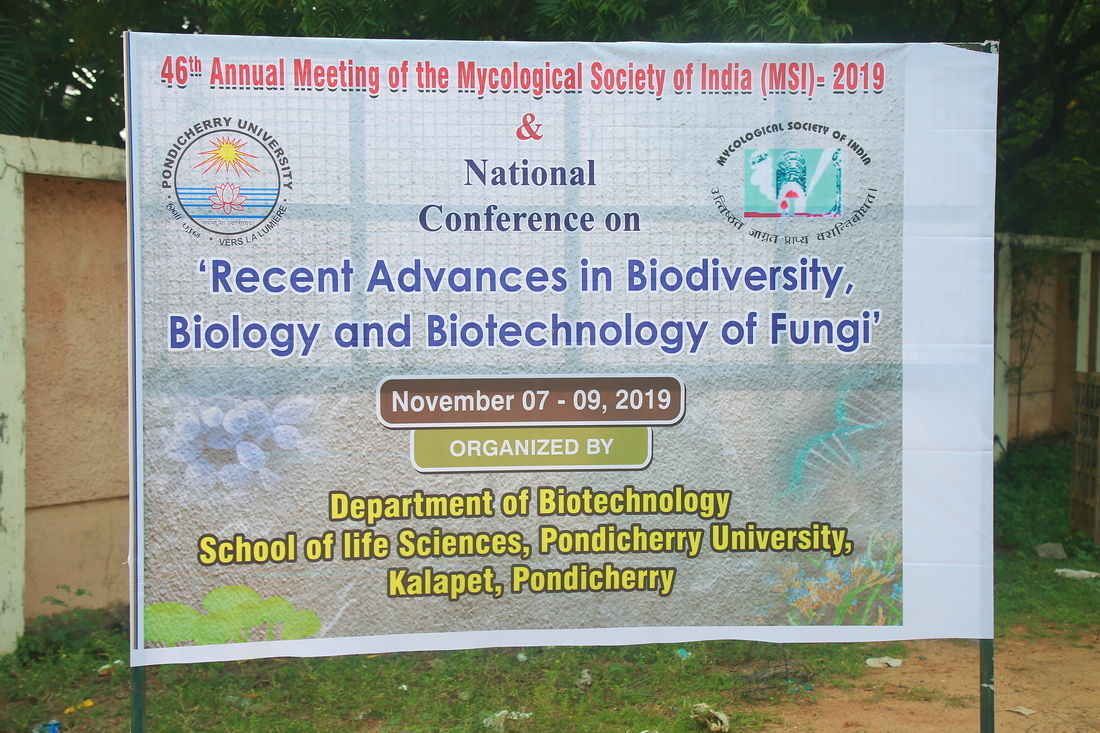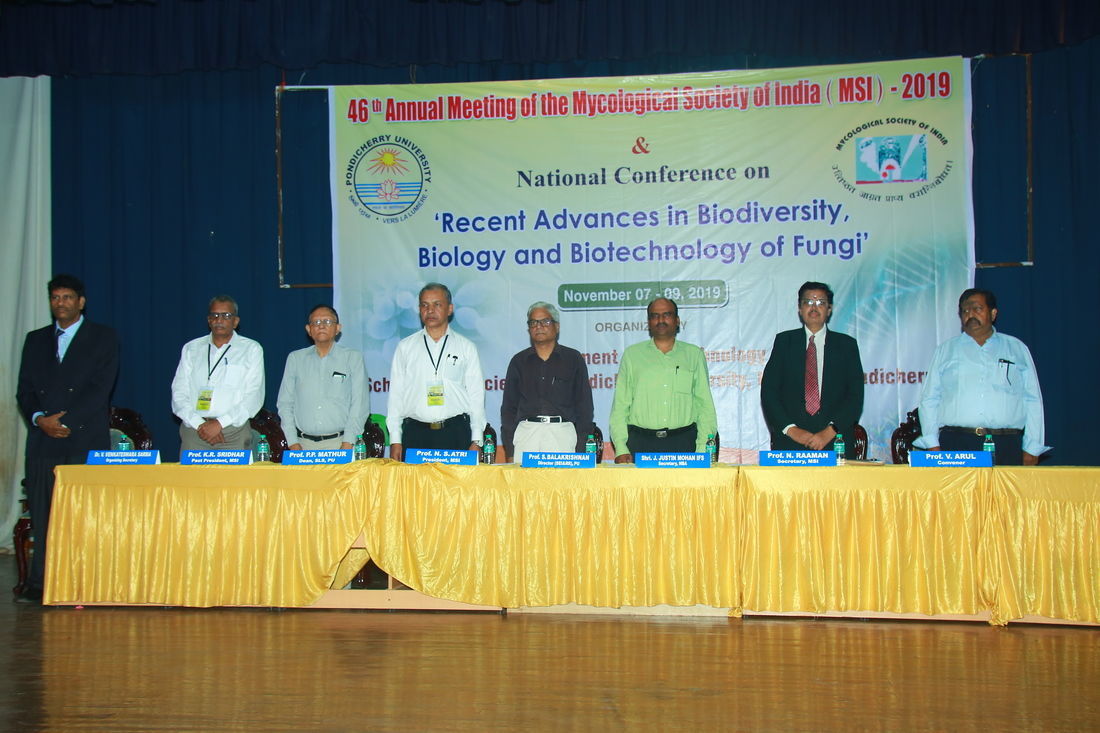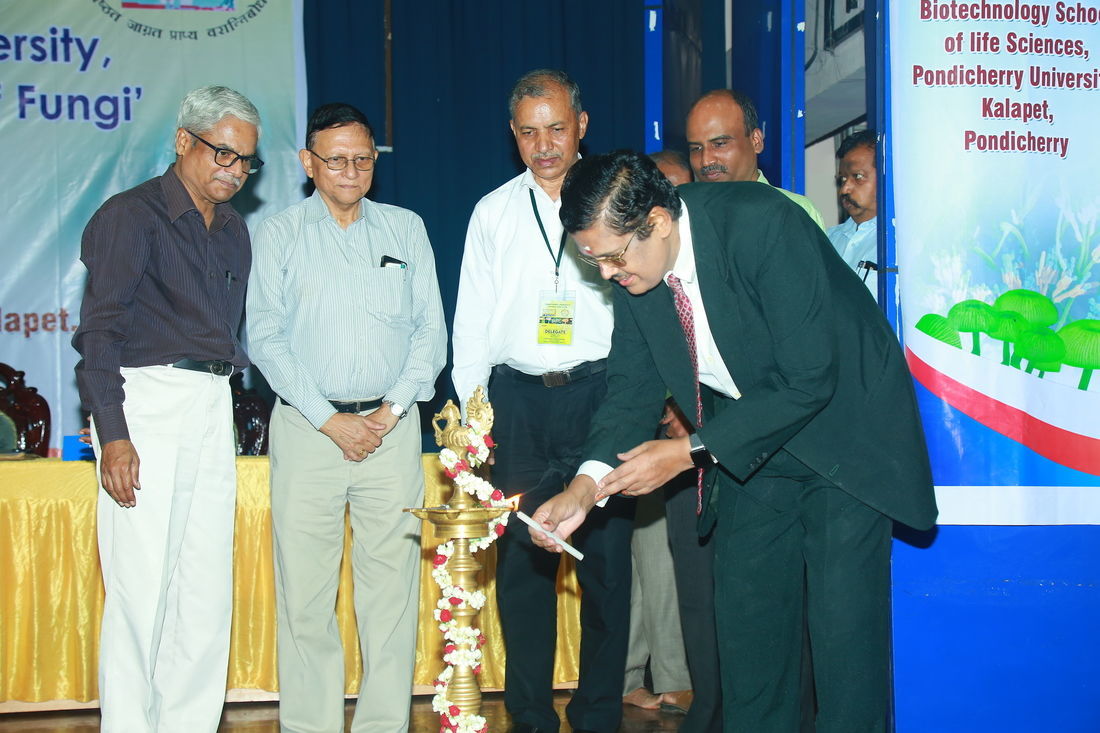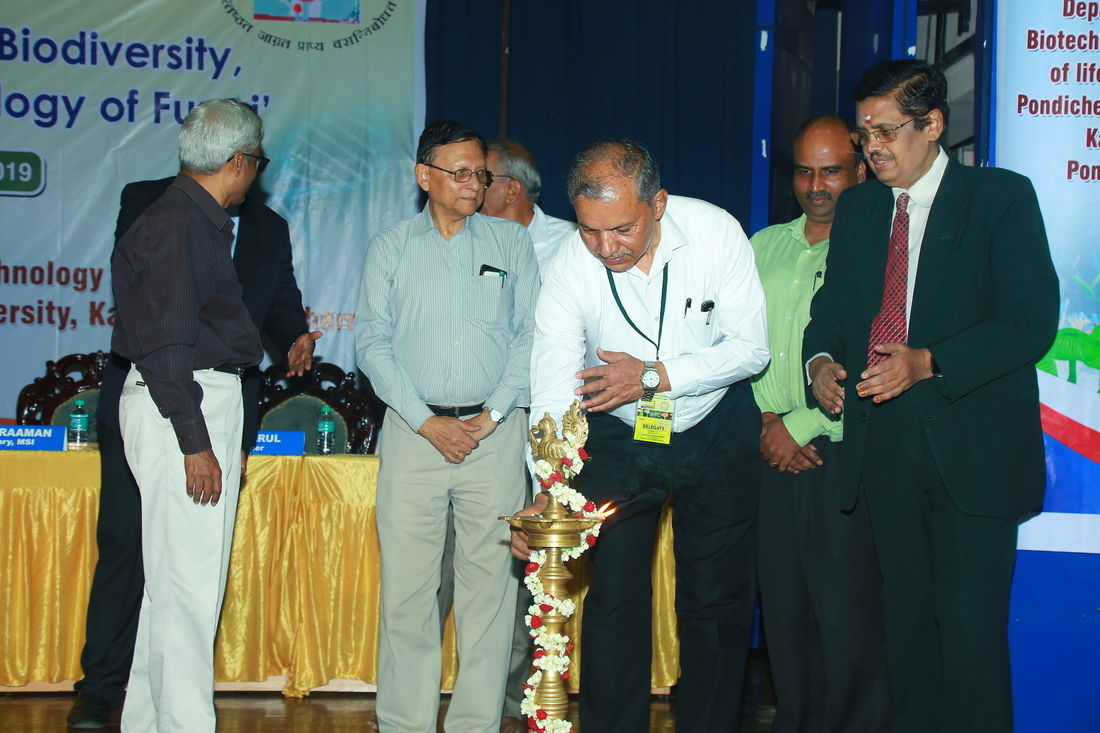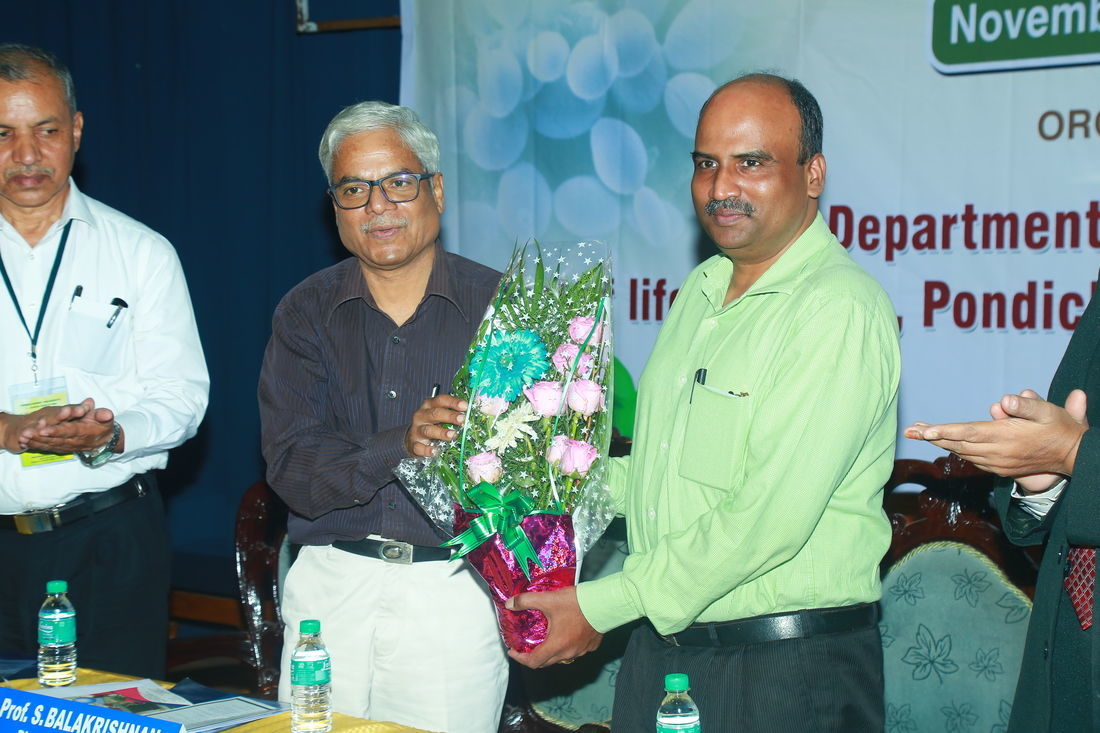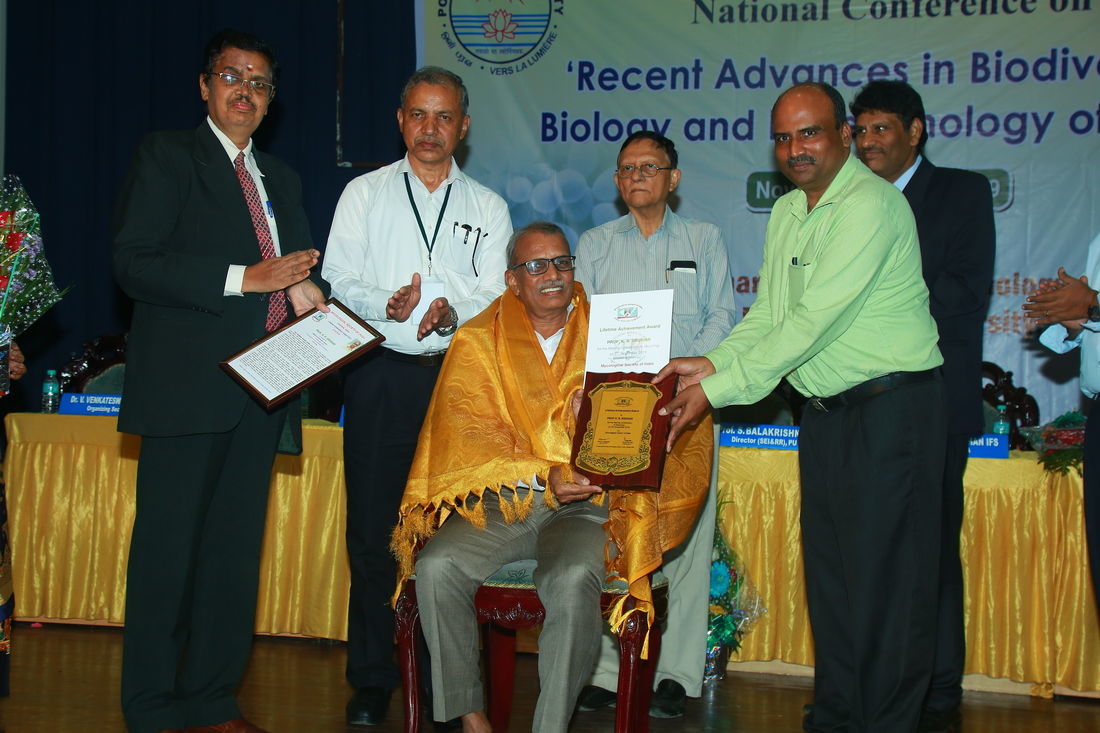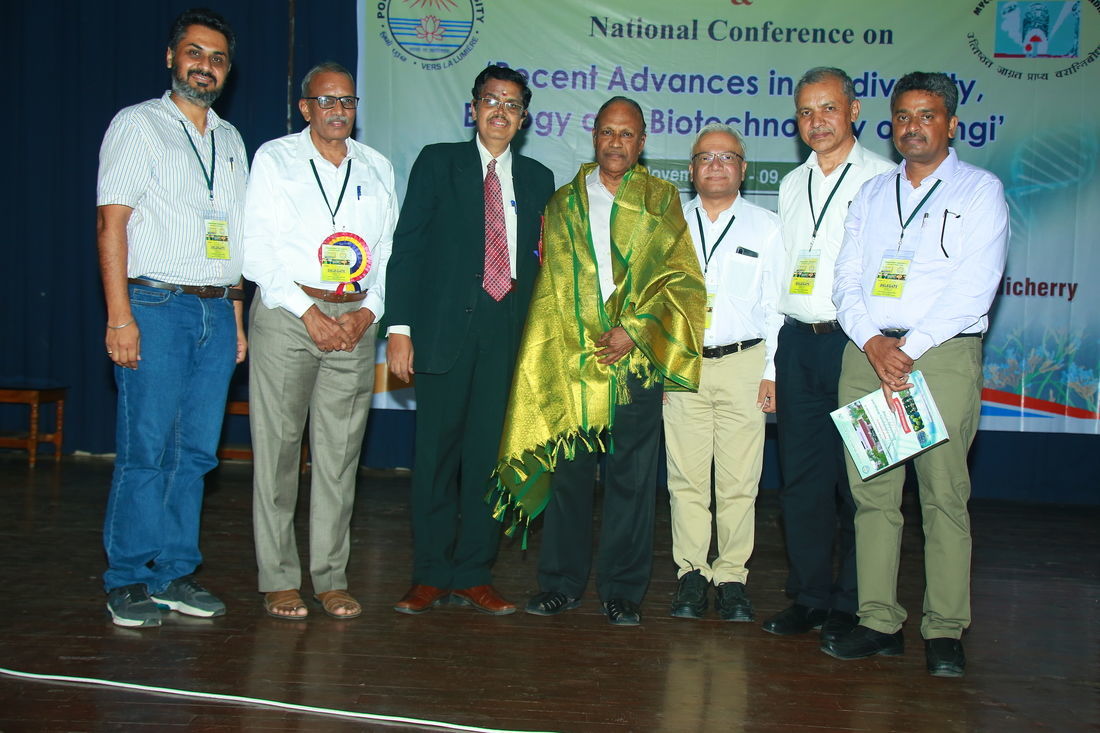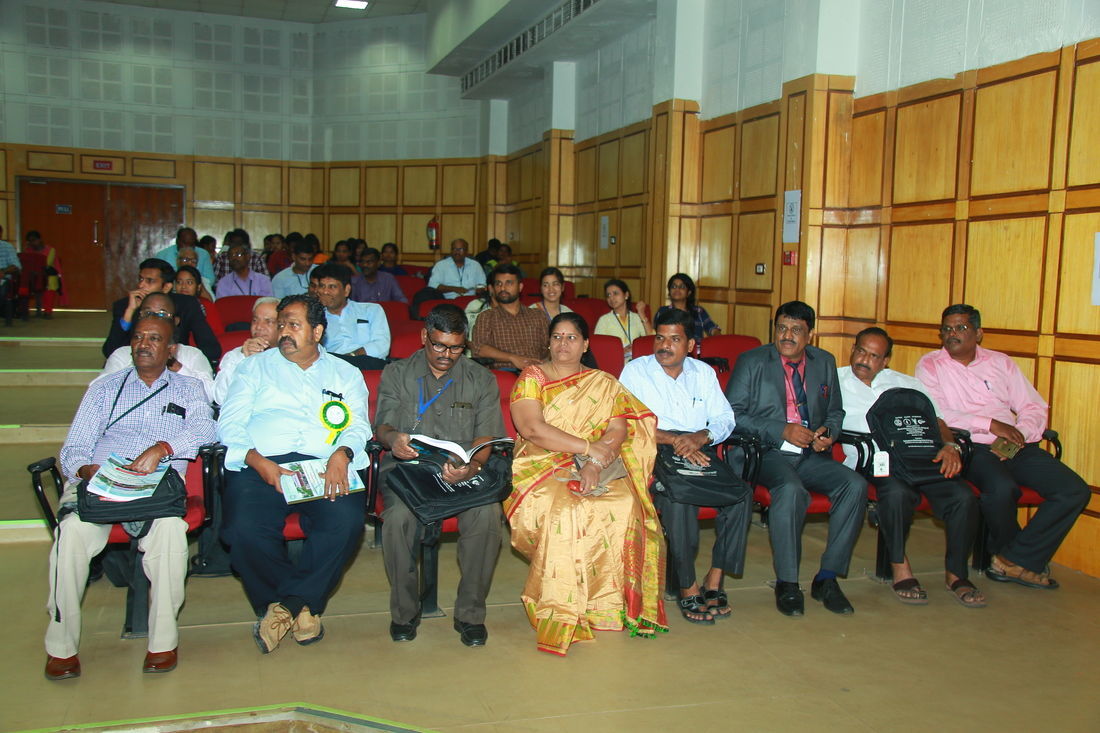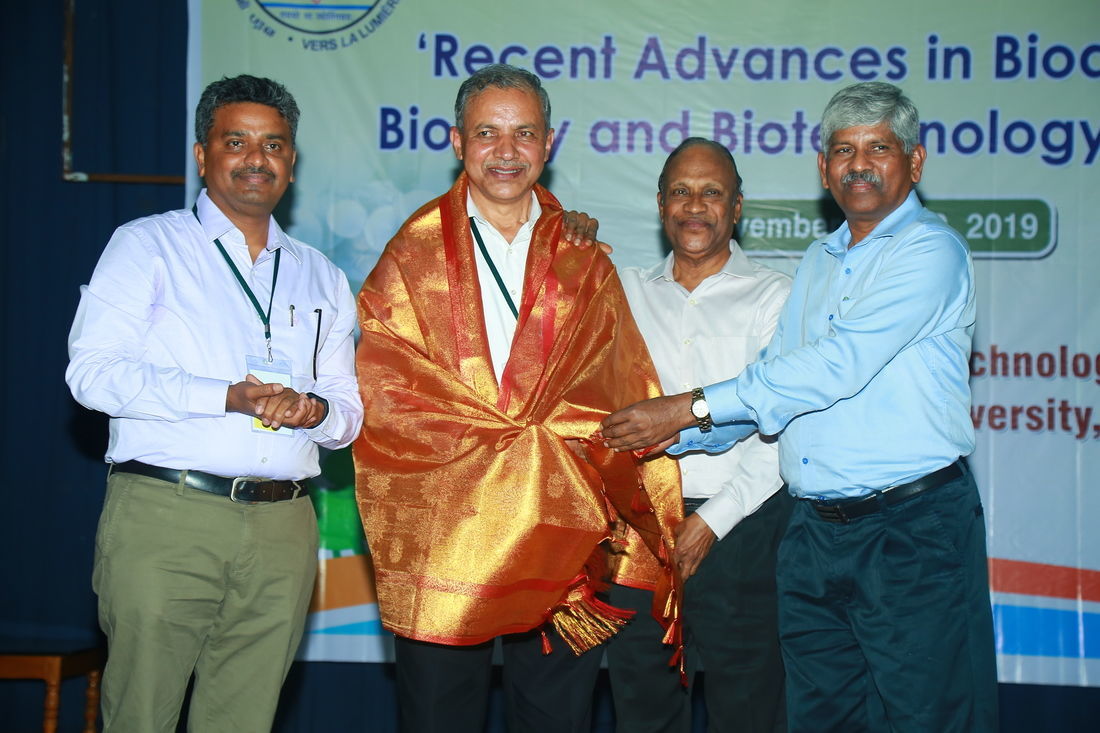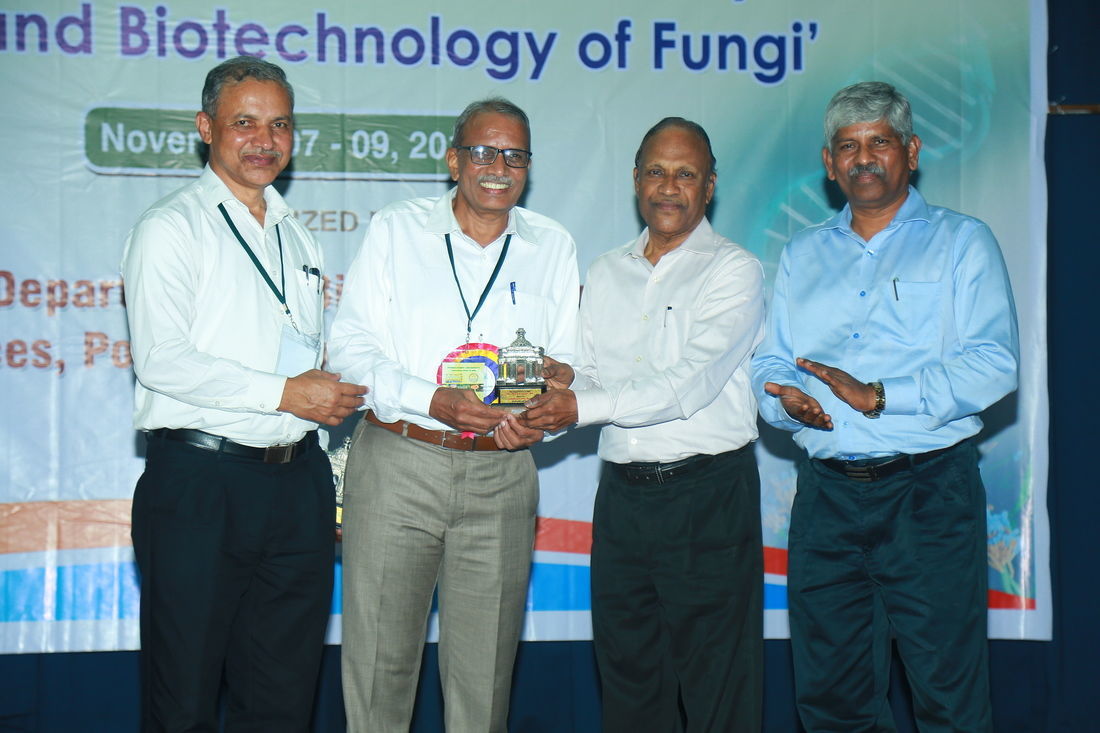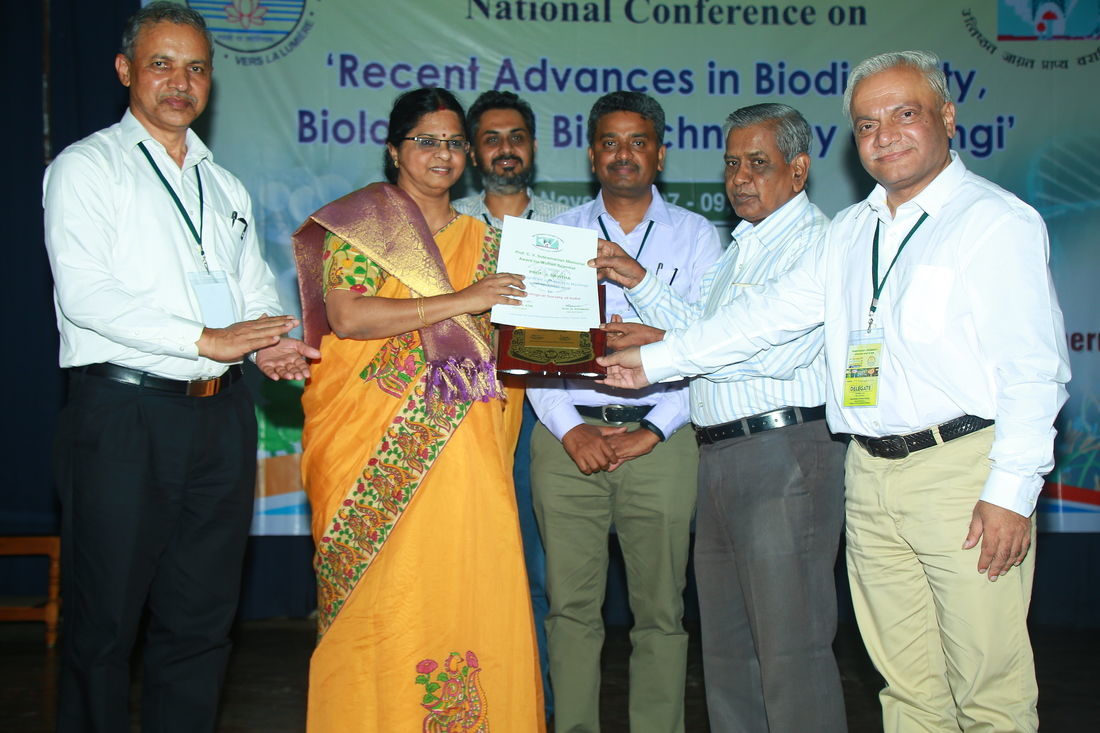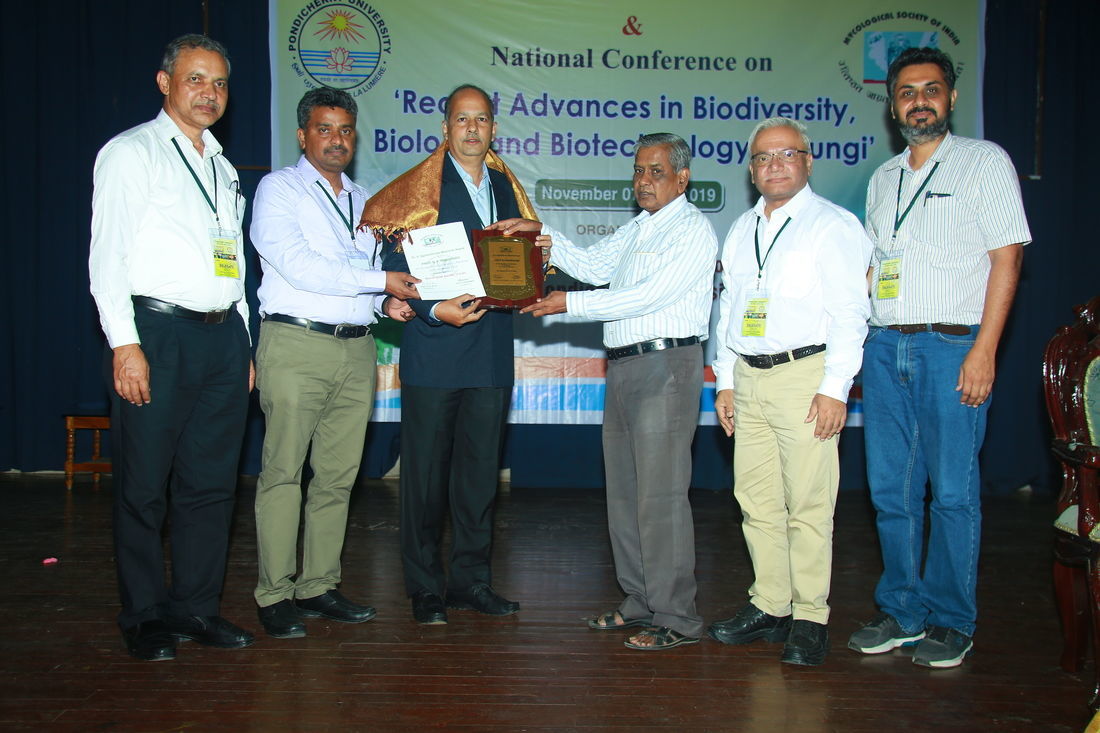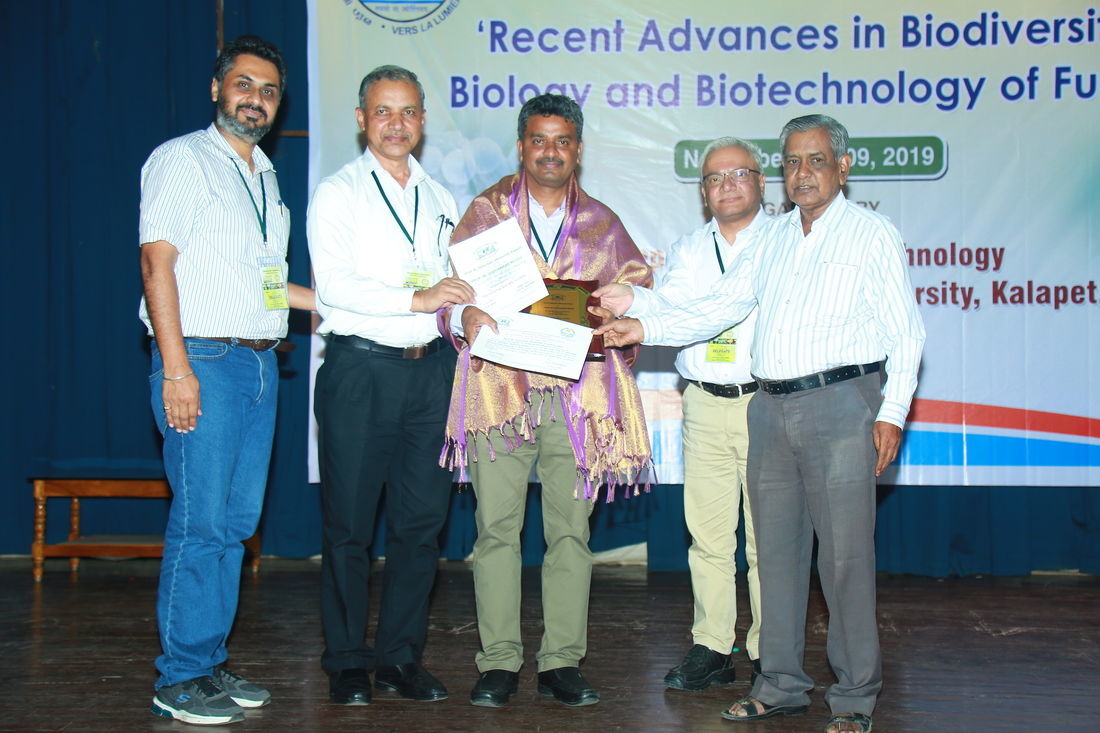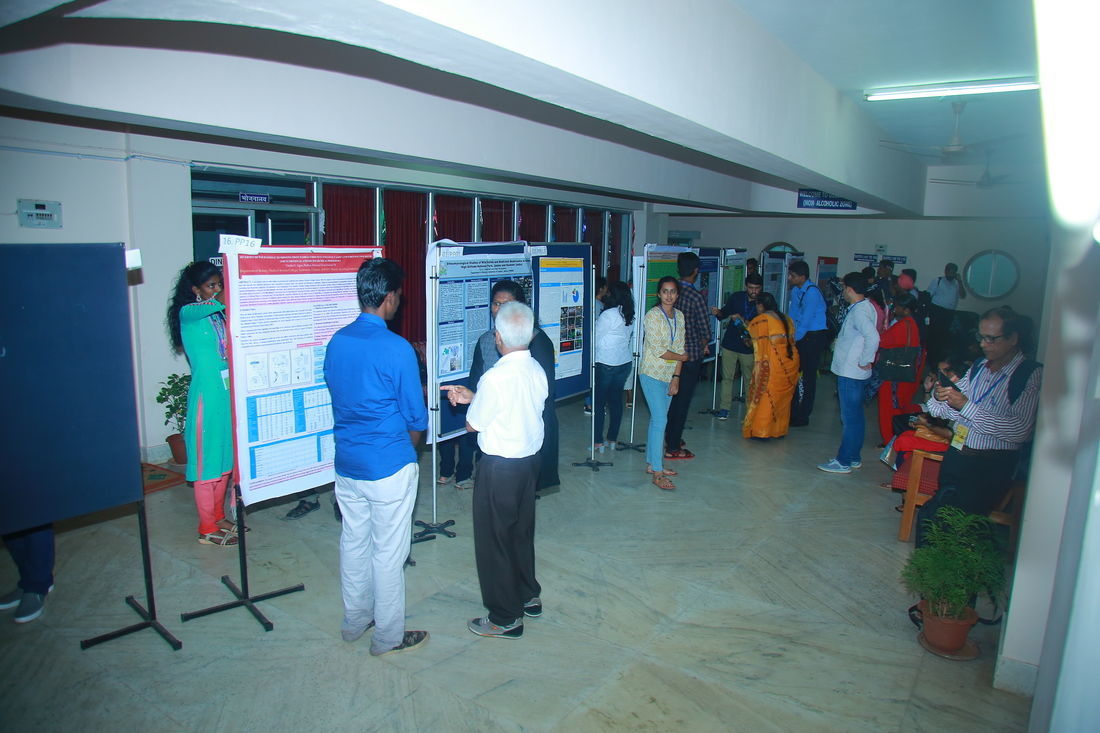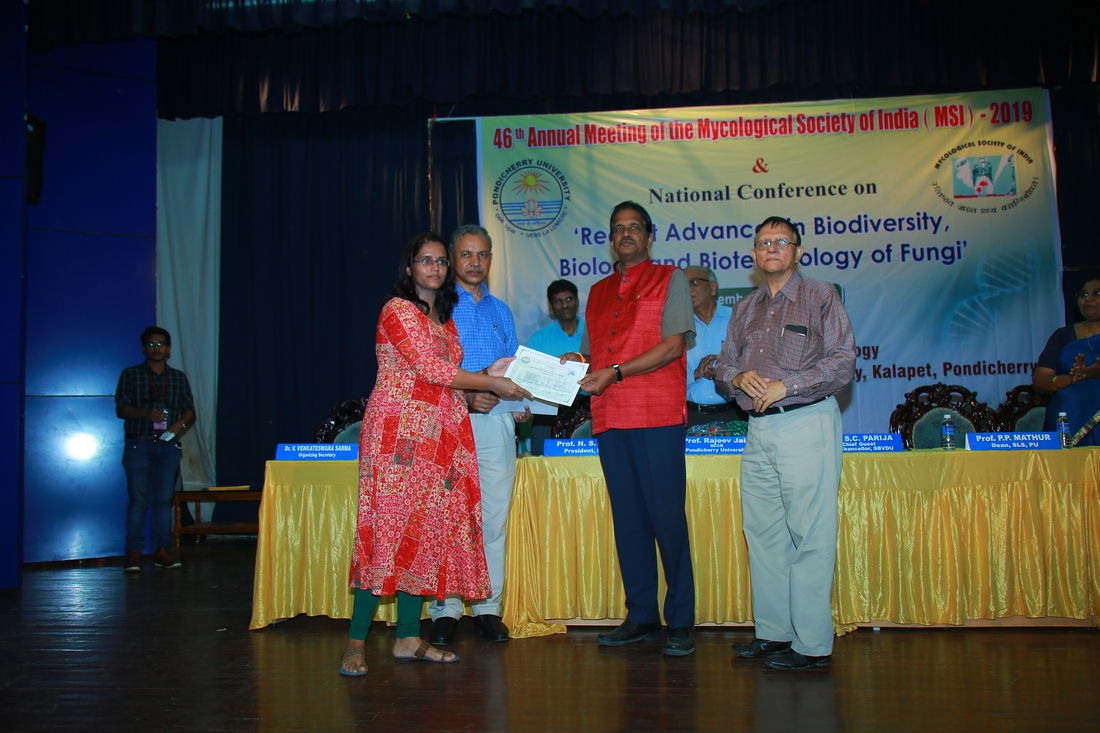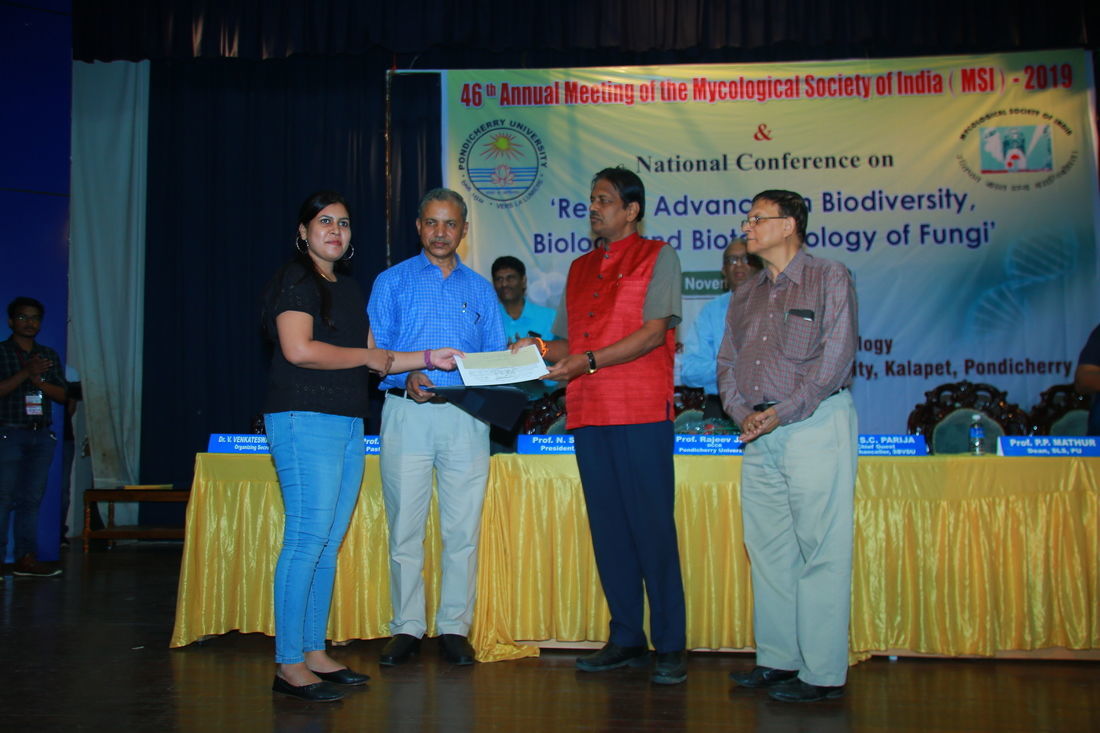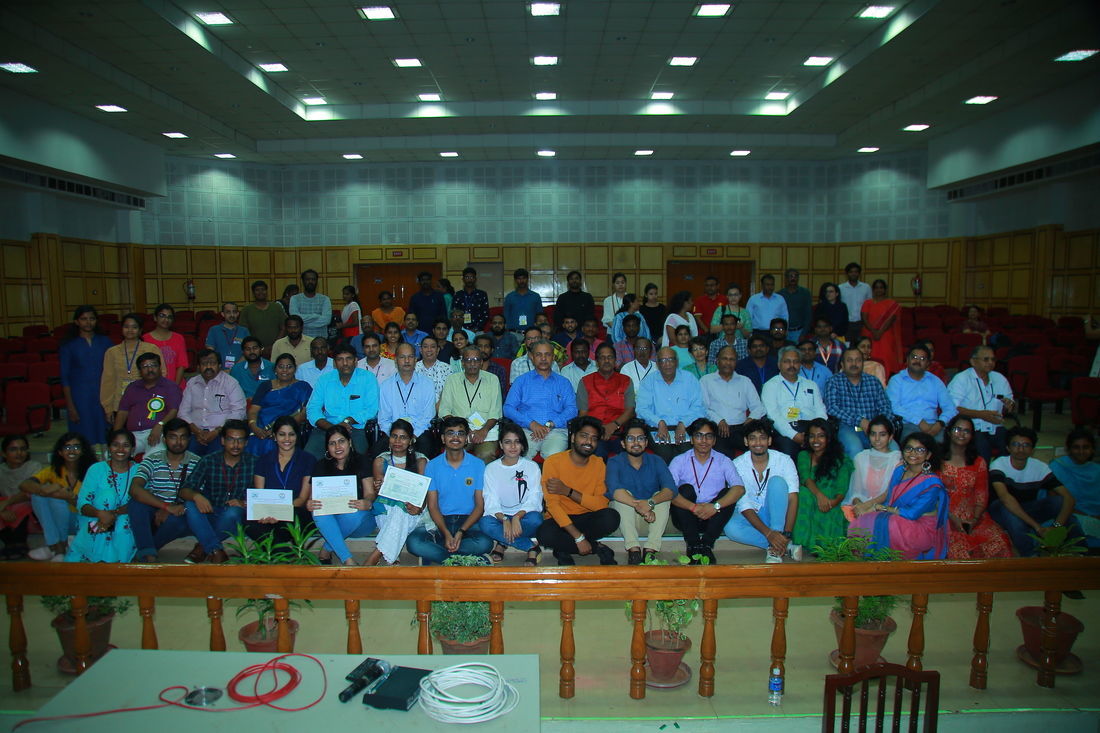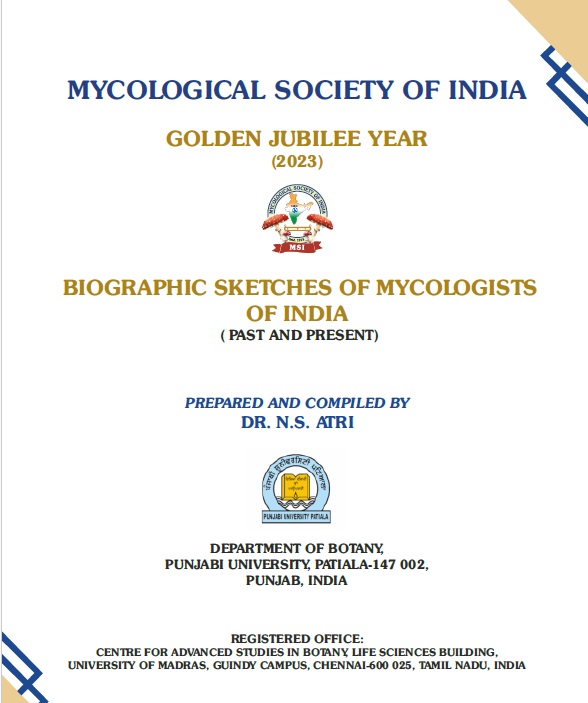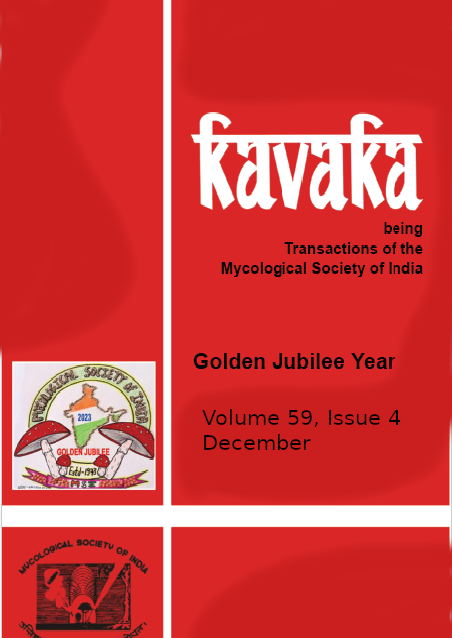Contents Front Pages
Front Pages
KAVAKA 57: 1-5 (2021) doi: 10.36460/Kavaka/57/2021/1-5
Increasing the chances of finding novel antibiotics to manage multidrug-resistant pathogens
Trichur S. Suryanarayanan1* and Florenz Sasse2
1Vivekananda Institute of Tropical Mycology (VINSTROM), Ramakrishna Mission Vidyapith, Chennai 600 004, Tamil Nadu, India
2Institute for Pharmaceutical Biology, Technical University of Braunschweig, 38124 Braunschweig, Germany
*Corresponding author Email: This email address is being protected from spambots. You need JavaScript enabled to view it.
(Submitted on October 13, 2021; Accepted on November 22, 2021)
ABSTRACT
The urgent need for antibiotics of novel molecular architecture to manage the rapid spread of multidrug-resistant pathogens (MDR) cannot be overstressed. It is obvious that compared with mere modifications of existing antibiotics, compounds of molecular structures hitherto not experienced by the pathogens would be more effective and also reduce the rate of evolution of drug resistance among them. We argue that instead of the routine exercise of bioprospecting different classes of microbes, the chances of finding such novel antibiotics are more if MDR pathogens are made to interact with microbes, especially with fungi from less explored and extreme habitats (LEEH).
Keywords: Antibiotic resistance, Bioprospecting, Extreme habitats, Antibiosis

KAVAKA 57: 6-12 (2021) doi: 10.36460/Kavaka/57/2021/6-12
Marine-derived fungi of Avicennia marina var. marina of a mangrove stand
V.V. Sarma*, Tauzif Raza, C. Sidhardha and Sujith Dharavath
Department of Biotechnology, Pondicherry Univeristy, Kalapet, Pondicherry 605 014, India
*Corresponding author Email: This email address is being protected from spambots. You need JavaScript enabled to view it.
(Submitted on June 02, 2021; Accepted on September 12, 2021)
ABSTRACT
Marine derived fungi were retrieved from living leaves (phyllosphere, phylloplane and endophytic niches), senescent and dead leaves of Avicennia marina var. marina from a mangrove stand near Marakkanam, Villupuram district, Tamil Nadu, East coast of India. In total 240 leaf bits each for phyllosphere, phylloplane and endophytic niches and 360 leaf bits each for senescent and dead leaves totaling 1440 leaf bits were processed. Totally, 64 morphologically identifiable fungal species belonging to 31 genera were encountered, while many non-sporulating morphotypes and producing only chlamydospores were also recorded. Aspergillus was the most speciose genus with 13 species followed by Penicillium and Drechslera (5), Curvularia (4), Cladosporium and Alternaria with 3 species were recorded. Of the 64 fungi only one fungus viz., Nigrospora sphaerica was recorded from all the niches i.e., phyllosphere, phylloplane, endophytic, senescent, dead leaves or soil samples. A. flavus, A. niger, Curvularia sp., Alternaria sp., were recorded in any 5 of the 6 niches. A. fumigatus, A. glaucus, A. niger 1, Aspergillus sp., Curvularia lunata, Drechslera australiensis, Penicillium sp. 1, Trichoderma sp. were recorded in any 4 out of the 6 niches. Seven fungi were common to any 3 niches. Twelve fungal species were common to any 2 niches. Thirty-two fungi were recorded only from any one of the 6 niches
Keywords: Diversity, Ecology, Marine fungi, Phyllosphere, Phylloplane, Leaf litter, Endophytes

KAVAKA 57: 13-18 (2021) doi: 10.36460/Kavaka/57/2021/13-18
Aspergillus niger strain HA106-H2: An endophyte from Gymnema sylvestre for anti-hyperglycemic potential
G.M. Vidyasagar1* Soumya Gawli1, Md. Liyakat Ali2, Shankaravva Babanagare1, Sangeeta Kamradgi1 and Ambika Vasanthkumar1
1Department of Botany, Gulbarga University, Kalaburagi - 585 106, Karnataka, India.
2Luqman College of Pharmacy, Kalaburagi - 585 106, Karnataka, India
*Corresponding author Email: This email address is being protected from spambots. You need JavaScript enabled to view it.
(Submitted on February 27, 2021; Accepted on July 12, 2021)
ABSTRACT
Gymnema sylvestre is an important medicinal herb traditionally used as anti-hyperglycemic agent. The present study was aimed to use the fungal endophytes as an alternate source to the plant. Ten endophytic fungal strains were isolated from the leaves of G. sylvestre. Of which the frequently recovered strain VSS -23 was identified as Aspergillus niger strain HA106-H2 and selected for further investigation. The crude solvent extracts of A. niger strain HA106-H2 employed in phytochemical screening showed the presence of alkaloids, phenols, flavonoids, tannins and saponins. The anti-hyperglycemic activity of the ethyl acetate extract at 250mg/kg of body weight in animal model (albino mice) exhibited 9.15% reduction in blood glucose level as compared to 6.25% reduction in standard drug acarbose at 50mg/kg concentration in 120 min after drug administration.
Keywords: Endophyte, Gymnema sylvestre, Aspergillus niger, Anti-hyperglycemic activity

KAVAKA 57: 19-22 (2021) doi: 10.36460/Kavaka/57/2021/19-22
Histoplasmosis in southeast Asia and Indian subcontinent: An update
Harish C. Gugnani
Department of Microbiology, Vallabhbhai Patel Chest Institute, University of Delhi, Delhi-110 007, India
Corresponding author Email: This email address is being protected from spambots. You need JavaScript enabled to view it.
(Submitted on July 17, 2021; Accepted on November 04, 2021)
ABSTRACT
Histoplasmosis caused by Histoplasma capsulatum var. capsulatum occurs worldwide being predominant in North America and Central America. Southeast Asia (SEA) and Indian subcontinent are areas of low endemicity with rates of prevalence varying in different countries. This review aims at providing an update on different aspects of histoplasmosis in SEA and the Indian subcontinent. A thorough search of the literature on histoplasmosis in SEA and the Indian subcontinent was made in PubMed, MEDLINE, Biomed Lib, Med Facts, using different keywords. Cross references in the relevant articles were used to down load the papers and extract important and pertinent information for incorporation int the review. The updated data on prevalence of histoplasmosis, sensitivity to the antigen histoplasmin and natural occurrence of H. capsulatum in different countries in southeast Asia and the Indian subcontinent is described. The varying clinical and pathological features of the cases are reviewed. The need for carrying out comprehensive studies to estimate the actual burden of histoplamosis in in (SEA) Asia and the Indian subcontinent is emphasized. A suggestion is made to augment the laboratory facilities and train laboratory personnel in the latest methods including molecular techniques to achieve this objective.
Keywords: Histoplasmosis, Prevalence, Histoplasma capsulatum, Sensitivity, Soil, Clinical features

KAVAKA 57: 23-27 (2021) doi: 10.36460/Kavaka/57/2021/23-27
Coprinopsis natarajanii sp. nov., a new marine basidiomycete from Puducherry mangroves, East coast of India
B. Devadatha1, V. Kumaresan2 and V. Venkateswara Sarma1*
1Fungal Biotechnology Laboratory, Department of Biotechnology, Pondicherry University, Kalapet, Pondicherry-605 014, India.
2Department of Botany, Kanchi Mamunivar Govt. Institute for Postgraduate Studies and Research, Airport Road, Lawspet, Puducherry 605 008, India
*Corresponding author Email: This email address is being protected from spambots. You need JavaScript enabled to view it.
(Submitted on June 17, 2021; Accepted on September 21, 2021)
ABSTRACT
Only a few basidiomycetous marine fungi are known from marine environments, while Ascomycota predominate the marine environments. In this paper, a novel species of Coprinopsis is reported from Indian mangroves based on the morphological and molecular phylogenetic analyses. The basidiomata and the pleurocystidia of the new species are smaller when compared to the other species of Coprinopsis.
Keywords: Basidiomycete, Mangrove fungi, Novel species, Phylogeny, Taxonomy

KAVAKA 57: 28-32 (2021) doi: 10.36460/Kavaka/57/2021/28-32
Amanita griseofusca: A new record to Indian mycobiota from Jammu and Kashmir, India
Anil Kumar, Tahir Mehmood and Yash Pal Sharma*
Department of Botany, University of Jammu, Jammu, Jammu and Kashmir, India.
*Corresponding author Email: This email address is being protected from spambots. You need JavaScript enabled to view it.
(Submitted on July 29, 2021; Accepted on September 09, 2021)
ABSTRACT
Amanita sect. Vaginatae is the most speciose section of Amanita subg. Amanita. However, to date, only one species belonging to this section have been reported from Jammu and Kashmir, India. Amanita griseofusca was collected along with several collections of Amanita from temperate forests of Jammu and Kashmir, India. It is reported here as the first record for India. A detailed morphological description and comparison with other closely related taxa of Amanita, as well as a molecular phylogeny are provided.
Keywords: Distribution, Temperate forest, nrLSU, taxonomy, Amanitaceae

 KAVAKA 57: 33-37 (2021) doi: 10.36460/Kavaka/57/2021/33-37
KAVAKA 57: 33-37 (2021) doi: 10.36460/Kavaka/57/2021/33-37
Quantification of lovastatin in two wild species of oyster mushrooms from India
Amita1*, Balwinder Kaur1 and N.S. Atri2
1Department of Botany, Sh. LBS, Arya Mahila College, Barnala (Punjab), India
2Department of Botany, Punjabi University, Patiala-147002, Punjab, India
*Corresponding author Email: This email address is being protected from spambots. You need JavaScript enabled to view it.
(Submitted on August 31, 2021; Accepted on December 08, 2021)
ABSTRACT
Lovastatin (C24H36O5) is one of the potentially used drugs for the reduction of blood cholesterol levels. It is reported to competitively inhibit the 3-Hydroxy-3-methyl glutaryl Co A (HMG Co A) reductase enzyme which acts as a rate limiting step in the cholesterol biosynthesis. Lovastatin is produced as secondary metabolite by various fungi including Pleurotus species. These mushrooms are gaining more importance as compared to other medicinal mushrooms in terms of health promoters and as environmental restorers resulting in upsurge in their R and D activities during the past decades. The present study pertains to the quantification of lovastatin from two indigenous strains of Pleurotus cystidiosus O.K. Mill and P. sapidus Quél. For this purpose, 15 days old culture of both the species growing in liquid yeast glucose medium was used. The study with spectrum analysis and high-performance liquid chromatography techniques confirmed the synthesis of lovastatin by two fungi.
Keywords: Oyster mushroom, Indigenous strains, Lovastatin, Cholesterol, Nutraceutical importance.

KAVAKA 57: 38-53 (2021) doi: 10.36460/Kavaka/57/2021/38-53
Nutraceutical, pharmaceuticals and industrial bioactive compounds of gasteroid fungi: A review
Sunil Choudhary1, Jaipal Singh2, Alkesh Tak2, Kamna Sharma2 and Praveen Gehlot2*
1Government College Jayal, Nagaur 341 001, Rajasthan, India
2Mycology and Microbiology Laboratory, Department of Botany, JNV University, Jodhpur 342 001, India
*Corresponding author Email: This email address is being protected from spambots. You need JavaScript enabled to view it.
(Submitted on September 16, 2021; Accepted on November 08, 2021)
ABSTRACT
The gasteroid fungi are the group of macro-fungi within the division Basidiomycota which produces spores inside the basidium unlike the other members of basidiomycetous mushroom. The gasteroid fungi are well recognized for their nutritional as well as therapeutic values throughout the world. Their fruiting bodies have been evaluated to be a magnificent source of digestible carbohydrates, proteins and fats with essential amino acids, dietary fibers, vitamins and minerals. Therapeutic significance of this group of fungi includes anti-cancerous activity either by suppressing the tumor cell lines or due to their immuno-modulatory properties through the production of bioactive compounds. The metabolites from them have also been proved to be a natural anti-inflammatory, antibiotics and antifungal agents that may substitute the drugs to provide a healthy food supplement without any adverse effects. The bioactive substances from these macrofungi are also known to lower the blood glucose level by regulating level of alpha amylases and aldolase reductase. The gasteroid fungi also known for potential antioxidant properties and aphrodisiac activity. The present study aims to review the diversity of gasteroid fungi and their role in production of potential bioactive metabolites especially of nutraceutical and therapeutic importance.
Keywords: Bioactive compound, Gasteroid fungi, Nutritional value, Medicinal properties

KAVAKA 57: 54-57 (2021) doi: 10.36460/Kavaka/57/2021/54-57
Deacylation of echinocandin B by immobilized Actinoplanes utahensis cells
M.C. Shivakumar1,2, S.H. Manohar,1 and J. Savitha2*
1RND, Biocon Limited, 20th KM, Hosur Road, Bengaluru-560 100.
2Department of Microbiology and Biotechnology, Bangalore University, Bengaluru-560 056
*Corresponding author Email: This email address is being protected from spambots. You need JavaScript enabled to view it.
(Submitted on October 08, 2021; Accepted on December 05, 2021)
ABSTRACT
Immobilized cells of Actinoplanes utahensis (NRRL 12052) were used to selectively cleave the acyl group of echinocandin B yielding the deacylated form, echinocandin B nucleus. The effects of temperature, pH and substrate concentration on deacylation by immobilized cells were studied. In independent experimental runs, MOPS buffer with pH 6.8, substrate concentration of 3 g/L at growth temperature of 24°C, resulted in >90% bioconversion (deacylation). Recycle ability of immobilized cells were evaluated and found to retain >90% bioconversion up to 4 cycles, after which decrease in bioconversion rate was observed. Stability of immobilized cells were also checked at 4°C and found to retain bioconversion ability of >90% up to 5 days. Immobilization of whole cells can be a better option to process for bioconversion of echinocandin B to echinocandin B nucleus.
Keywords: Antifungals, Echinocandin B, Anidulafungin, Acylase, Immobilization, Sodium alginate

KAVAKA 57: 58-61 (2021) doi: 10.36460/Kavaka/57/2021/58-61
Spawn run dynamics of two Calocybe indica strains (DMRO-309 and APK-2) on agrowastes
S.P. Pourush Shrikhandia* and Geeta Sumbali
Department of Botany, University of Jammu
*Corresponding author Email: This email address is being protected from spambots. You need JavaScript enabled to view it.
(Submitted on October 28, 2021; Accepted on December 20, 2021)
ABSTRACT
Cultivation of mushroom is an eco-friendly activity, which represents solid state fermentation, an important technology in which agrowastes and other lignocellulosic wastes are converted into valuable protein rich food. Since last few decades, it has gained lot of importance due to increasing demand for high quality proteins, minerals and vitamins, which can directly benefit human health. Mushroom are probably the highest protein producers per unit area and time due to the utilization of vertical space and short life cycle. One such promising mushroom is Calocybe indica P&C (milky white mushroom/ summer mushroom) commonly known as 'kuduk' or 'dudhichatta', whose two strains viz., DMRO-309 and APK-2 were cultivated on different agrowastes and their combination and the time period required for complete colonization was evaluated. It was observed that both these strains exhibited statistical differences in the time period taken for colonization of different agrowastes and their combinations. Further, it was observed that C. indica strain DMRO-309 was a faster colonizer than APK-2
Keywords: Milky mushroom, Lyophyllaceae, Colonization, Substrate, Mycelial growth

KAVAKA 57: 62-65 (2021) doi: 10.36460/Kavaka/57/2021/62-65
Four new reports of resupinate non-poroid fungi from India
Ellu Ram, Avneet Pal Singh* and Gurpaul Singh Dhingra
Department of Botany, Punjabi University, Patiala, 147 002, Punjab, India
*Corresponding author Email: This email address is being protected from spambots. You need JavaScript enabled to view it.
(Submitted on October 28, 2021; Accepted on December 18, 2021)
ABSTRACT
Four species of resupinate, non-poroid fungi i.e., Chaetodermella incrassata (Malençon) K.H. Larss. & Ryvarden, Cylindrobasidium torrendii (Bres.) Hjortstam, Dendrothele amygdalispora Hjortstam and Sistotrema oblongisporum M.P. Christ. & Hauerslev are described as new to India based on the on material collected from Kullu district of Himachal Pradesh (India).
Keywords: Agaricomycetes, Basidiomycota, Fungi, Himalaya, Wood rot

KAVAKA 57: 66-73 (2021) doi: 10.36460/Kavaka/57/2021/66-73
Arbuscular mycorrhiza facilitates growth of micropropagated plants and seedlings of black plum, Syzygium cumini
Neeru Jain1, Renuka Rawat1, Samta Gupta1, Sadhana Babbar2* and Shashi B. Babbar1*
1Department of Botany, University of Delhi, Delhi, 110 007, India
2Swami Shraddhanand College, University of Delhi, Delhi, 110 036, India
*Corresponding authors Email: This email address is being protected from spambots. You need JavaScript enabled to view it., This email address is being protected from spambots. You need JavaScript enabled to view it..
(Submitted on November 30, 2021; Accepted on December 18, 2021)
ABSTRACT
One of the major impediments to the success of micropropagation is the poor establishment and survival of in vitro developed plants on transfer to soil. To ameliorate this problem, effects of two arbuscular mycorrhiza fungi (AMF), Rhizophagus fasciculatus and R. macrocarpus, either alone or in combination, were studied on the growth and nutrient status of micropropagated plants and seedlings of Syzygium cumini. Symbiotic association with AMF was beneficial for the overall growth of both types of plants. However, the degree of positive effects on growth varied with the plant type as well as the species of AM fungus used. R. macrocarpus induced profuse lateral branching of the main root, while R. fasciculatus induced elongation of the main roots. The combination of the two proved to be the best for the overall growth of seedlings as well as the micropropagated plants. In seedlings, colonization of AM occurred in the lateral roots arising from the maturation zone of the taproot, indicating recognition and establishment of AM during the early stages of development. This was further confirmed by the observed higher mycorrhizal dependency (MD) during the initial growth period. With time, MD declined slightly as the plants became partially independent of AM. Except for Mn2+, the levels of cations viz., K+, Mg2+, Fe2+, Cu2+ and Zn2+, and two anions viz., PO42- and NO32- were higher in AM treated plants than the respective controls. The present study demonstrates the potential of AMF in the alleviation of transplantation stress and better growth of micropropagated plants of S. cumini.
Keywords: Micropropagation, Mycorrhiza, Myrtaceae, Rhizophagus, Tissue culture, Transplantation

KAVAKA 57: 74-78 (2021) doi: 10.36460/Kavaka/57/2021/74-78
Some new reports of corticioid fungi from Mandi district (Himachal Pradesh)
Rajni Devi1 and Jaspreet Kaur2*
1Department of Botany & Environmental Science, Sri Guru Granth Sahib World University, Fatehgarh Sahib, 140407, Punjab, India
2Department of Agriculture, Sri Guru Granth Sahib World University, Fatehgarh Sahib, 140407, Punjab, India
*Corresponding author Email: This email address is being protected from spambots. You need JavaScript enabled to view it.
(Submitted on October 02, 2021; Accepted on December 22, 2021)
ABSTRACT
Seven species of the corticioid fungi, Botryohypochnus isabellinus, Dendrothele alliacea, Gloeocystidiellum furfuraceum, Hyphodontia alutaria, H. pallidula, Peniophora cinerea and Resinicium furfuraceum are described as new to Mandi district (Himachal Pradesh). Of these, Gloeocystidiellum furfuraceum and Resinicium furfuraceum are recorded as new for Himachal Pradesh. Genus Peniophora is being described for the first time from Mandi district.
Keywords: Basidiomycota, Agaricomycetes, wood rotting fungi, Himalaya

- FUNGAL AWARENESS WEEK - 27th September - 2nd October organised by Shri Shivaji Education Society Amravati's Shri Shivaji Science College, Amravati (Click for Details)
- Meeting and Seminar at Centre of Advanced Study in Marine Biology, ANNAMALAI UNIVERSITY, Chidambaram, India (Click for Details)
- Mycological Society of India, Mumbai Unit in association with Department of Botany, NES Ratnam College under DBT-Star Status (Click for Details)
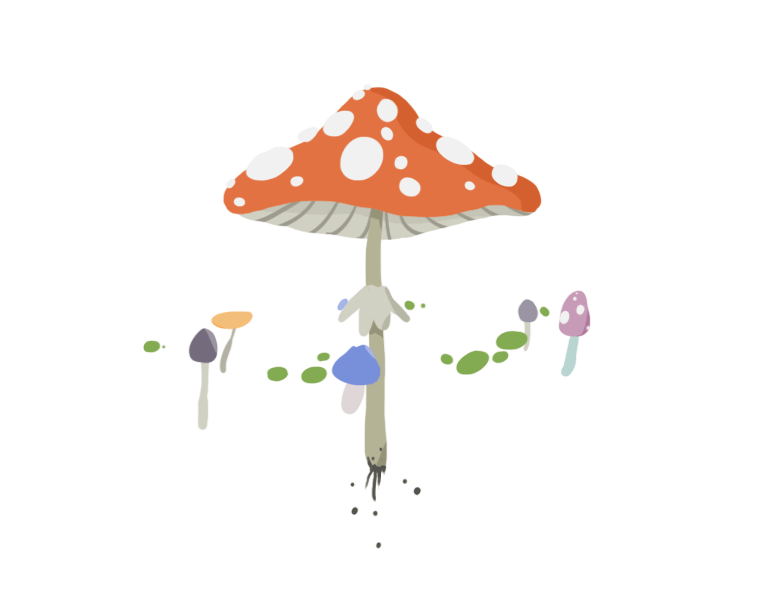
From the Editor's Desk
After a brief sigh of relief from tumultuous 2020, as we stepped into the year 2021, people around the world and more particularly in India are once again grappling with the ferocity of the Covid-19 pandemic encompassing both rich and poor, all ranks and professions, classes, and nationalities. The fury of this ever-mutating RNA virus is still wreaking havoc with a spate of unprecedented and unforeseen events witnessed all across the country. In addition, mucormycosis, a rare but dangerous fungal infection of the sinuses, the brain and the lungs caused by the members of the Mucorales in diabetic or severely immunocompromised individuals have become life-threatening in severe and critically ill Covid-19 patients. Besides being known for diverse biological transformations, food and feed supplements, medicines, and neutraceuticals recently the negative side of this ubiquitous, predominantly saprobic soil and air-borne opportunistic group of fungi including Rhizopus arrhizus, Mucor circinelloides and lesser known Rhizomucor miehei, Syncephalastrum, Cunninghamella bertholletiae, Apophysomyces spp., Lichtheimia spp., and Saksenaea vasiformis has raised serious concern for the medical mycologists and practitioners. The challenge seems to have become bigger since the appearance of mucormycosis on the scene, if not controlled, can further, increase the susceptibility to the fatal pathogenic infections such as candidiasis, cryptococcosis, histoplasmosis, blastomycosis, and several other systemic human fungal mycoses. Therefore, the proper etiological diagnosis, epidemiology, and the susceptibility of humans, and availability of rapid and an effective therapy against varied mycoses are the main challenges confronting all of us.
While the pandemic had and is still having a huge impact on various aspects of human life, the bearing of it on the scientific community is huge. We have lost several great academicians, researchers, professionals and common man in this viral scourge. While their immense contributions to society at different levels will keep on inspiring and motivating the younger generation, our tributes and respectful homage to their departed souls and the eternal sacrifice they have made. With the adoption of the Covid-19 appropriate behaviour and rolling out and approval of multiple vaccines, there has been a ray of hope of a better world and global growth would likely rebound given the confluence of internal and external support factors. And now we are looking forward to positivity and hope that our hard work and resilience brighten the future of one and all.
As the Editor-in-Chief of Kavaka, I feel that several challenges confront us in maintaining the quality and global acceptability of Kavaka: a) reposing faith in the journal Kavaka by the scientific community; b) quality research article contributions keeping in view the global standards of manuscripts routed for publication in the Kavaka, especially the requirements and best practices for describing a new fungal species (Aime et al., 2021 in IMA Fungus) and allied data on their ecological and environmental significance; c) availability of active reviewers for critical evaluation following the recent research trends; and d) fostering cross-disciplinary collaborations. It seems rather easy to create a new taxon than searching the literature related to it. The challenge is not only publishing and advancing the high-impact quality science, but also maintaining its critical standards and global acceptance.
While there have been numerous challenges to navigate, yet we're proud that the scientific fraternity has very quickly responded and adapted to circumstances. The entire mycological fraternity of researchers, the authors, reviewers are thanked and acknowledged for their warrior-like role. Their continued involvement and consistency have set the ball of academics and research rolling.
I am deeply grateful to the members of the Mycological Society of India, in general, and the contributors (editorial board, authors, and reviewers) for their support, insights, and enthusiasm. Together, we make a wonderful team and I am excited to work with them in our shared mission of advancing mycology for the benefit of science and all of society. I sincerely acknowledge the unstinting support by Prof. N.S. Atri, formerly Editor-in-Chief Kavaka, for his constant help in meeting the challenge of timely publication of the present volume of Kavaka and Mr. Gulshan Pal Singh (Technical Assistant) is thanked for the computer setting of the manuscripts.
June 30, 2021
Yash Pal Sharma
(Editor in Chief KAVAKA)
Professor, Department of Botany, University of Jammu,
Jammu-180 006 (J&K) INDIA
Contents Front Pages
Front Pages

KAVAKA 56: 1-7 (2021) DOI: 10.36460/Kavaka/56/2021/1-7
Arbuscular mycorrhiza in sustainable agriculture: Prospective and challenges
Rupam Kapoor
Department of Botany, University of Delhi, Delhi - 110007
Email : This email address is being protected from spambots. You need JavaScript enabled to view it.
At a time in which global food demand is exponentially increasing with concomitant shrinkage in the availability of farmable lands, microbes furnish a key role in sustainably optimizing agricultural processes. One such significant group of microbes that is extremely instrumental in sustainable agriculture is Arbuscular Mycorrhizal Fungi (AMF). This group of fungi thrives in soil and is crucial to the multitudinous biological functions of plants. My interest in Plant-AMF interactions would not have had the spirit it has without the inevitable support of my supervisor, Late Prof. K.G. Mukerji, whose wisdom, passion for science, and authoritative guidance have been immeasurably valuable in my growth as a person and blossoming scientific temperament in me over all these years. My greatest degree of appreciation goes out to him for exposing me to the realms of this promising group of beneficial fungi that serve as agro-ecosystem engineers by fostering crop growth, securing nutrients, and even fending off pests and pathogens. The natural benefits of these microbes are a powerful complement to existing plant and soil treatments. I place on record my sincere gratitude to the honorable members of the Mycological Society of India (MSI) for entrusting me and putting me at the forefront. I appreciate the very foundation and vision of MSI that has the endeavor to bring together the mycologists of the country and with the broad objective of promoting the growth of mycology in India with wider perspectives. It is with great pleasure and humility that I express my deep sense of gratitude for having been able to serve this society over the years and pledge to continue to do so to the best of my ability. We, as a society, can go long in cultivating the interest of young researchers in mycology and its application and in realizing the long chased vision of sustainable agriculture.

KAVAKA 56: 8-12 (2021) DOI: 10.36460/Kavaka/56/2021/8-12
Impact of various cultural parameters for extracellular pectinase production by some Fusarium oxysporum isolates in surface batch broth fermentation
Pinki Tikadar and Bejoysekhar Datta*
Mycology and Plant Pathology Research Laboratory, Department of Botany, University of Kalyani-741245, West Bengal, India.
*Corresponding author Email : This email address is being protected from spambots. You need JavaScript enabled to view it.
(Submitted onApril 13, 2021; Accepted on May 19, 2021)
ABSTRACT
Pectinase has tremendous industrial application. Filamentous fungi such as Fusarium oxysporum might be exploited as a commercial source of pectinase. Three F. oxysporum isolates from rhizosphere of grass pea (Lathyrus sativus L.), tomato (Solanum lycopersicum L.) and potato (Solanum tuberosum L.) were used in the study. They showed transparent zone around their colony on pectin agar plate. Crude enzyme was prepared by growing them in pectin broth and various culture parameters were optimized for maximum production of pectinase. All the three isolates showed highest pectinase production after 6th day of incubation at 30°C in the medium having pH range 5.5 - 6.5 and supplemented with 0.5% pectin. Among the nine culture media studied, maximum activity was observed in Czapek's Dox broth (3.37, 3.83 and 2.96 U/ml), moderate activity in malt extract broth and least activity was observed in Asthana and Hawker's broth. In the CDB medium when sucrose was replaced with other carbon sources, maximum activity was obtained in presence of pectin followed by dextrose and least activity in mannitol. Among nitrogen sources, amino acids such as glycine and glutamine supported maximum production of pectinase in tomato and potato isolates and peptone in grass pea isolate. Thus, the isolates could be treated as effective producer of pectinase enzymes with various biotechnological applications.
Keywords: Incubation time, temperature, pH, nutritional supplement

KAVAKA 56: 13-21 (2021) DOI: 10.36460/Kavaka/56/2021/13-21
Appraisal of native AM fungi in improving the plant productivity, soil health and sequestering soil carbon in agroecosystems
Mahaveer P. Sharma
ICAR-Indian Institute of Soybean Research, Khandwa Road, Indore -452001
*Corresponding author Email: This email address is being protected from spambots. You need JavaScript enabled to view it.
(Submitted on May 14, 2021; Accepted on June 10, 2021)
ABSTRACT
The soils under tropical and sub-tropical regions are generally nutrient deficient, marginally fertile and growers rely on sub-optimal yields. Among the soil biota, the role of arbuscular mycorrhizal (AM) fungi in sustainable agriculture have been widely recognized. AM inoculation in horticultural and crop plants in the field and during the hardening stage has been shown to improve the plant stand, plant health, saved chemical fertilizer inputs. The crop productivity further improved when AMF is applied with PGPR. AM fungi also improving soil through production of glomalin which contributes to the soil carbon pool. Based on stabilized field studies, the functioning of nativeAMF enhances crop productivity and soil carbon sequestration under organic and conservation tillage with maize-based crop sequences. These fungi can be produced routinely on host plants in potting substrates, on-farm, and using Ri-plasmid hairy roots under in vitro. Besides employing the conventional microscopic methods (spore density and root colonization), its functioning can be carried out through biochemical methods such as AM-signature 16:1ω5 phospholipid and neutral fatty acids, and glomalin. The production of AM fungi, its quality assurance, and its application in the field for nutrient mobilization and carbon mitigation should be popularized through large-scale field demonstrations at multiple locations.
Keywords: AM signature fatty acids, crop production, farming practices, glomalin, soil carbon sequestration

KAVAKA 56: 22-28 (2021) DOI: 10.36460/Kavaka/56/2021/22-28
Opportunistic yeasts causing onychomycosis among some elderly residents of Rajouri district, J&K (India)
Anjali Sharma and Geeta Sumbali*
Department of Botany, University of Jammu, BR Ambedkar Road Jammu-180006 (India)
*Corresponding author Email : This email address is being protected from spambots. You need JavaScript enabled to view it.
(Submitted on December 23, 2020; Accepted on April 13, 2021)
ABSTRACT
Onychomycosis is the fungal infection of toenails and fingernails, which can be caused by dermatophytes, non-dermatophytic filamentous fungi and yeasts. Among these, yeasts are a group of fungi widely distributed in nature and can be found in the soil, air, water, food, etc. In human beings, they are occasionally a part of the normal microbiota of gastrointestinal tract, respiratory tract, reproductive tract and skin. However, these can cause superficial as well as systemic infections when a person is immunocompetent or his/her normal flora gets altered. In the last few decades, yeasts are emerging as the common etiological agents of onychomycosis. During a survey conducted for the first time in Rajouri district (Union Territory of Jammu and Kashmir), toenails and fingernails of the elderly residents were visually scanned for dystrophies and sampled for knowing the etiologic agents. Investigations revealed the presence of three yeast species viz., Candida albicans, Trichosporon asahii and Rhodotorula mucilaginosa associated with the dystrophied nails of some of the residents.
Keywords: Onychomycosis, Candida albicans, Trichosporon asahii, Rhodotorula mucilaginosa

KAVAKA 56: 29-35 (2021) DOI: 10.36460/Kavaka/56/2021/29-35
Preliminary studies on the domestication of an indigenous strain of Pleurotus cystidiosus collected from the living stem of Lagerstroemia speciosa
Amita1*, R.C. Upadhyay2, M.K. Saini1 and N.S. Atri1&3
1Department of Botany, Punjabi University, Patiala-147002, Punjab, India.
2Prerna Shikhar Apartment, Near Bodakdev Fire Station, Ahmedabad-380054, Gujarat, India.
3Presentaddress: Attri’s Paradise, Officer’s Colony, J. B. T. Road, Kotla Nala, Solan-173212, Himachal Pradesh, India
*Corresponding author Email: This email address is being protected from spambots. You need JavaScript enabled to view it.
(Submitted on March 16, 2021; Accepted on May 06, 2021)
ABSTRACT
Oyster mushrooms (Pleurotus spp.) are popular throughout the world because of their tremendous stability of pileus and stipe, cooking qualities, and longer shelf life. During the present investigations pure culture of P. cystidiosus O.K. Mill. was raised through standard tissue culture technique from the fresh young sporophore collected from nature. Subsequently, its spawn was prepared on supplemented wheat grains with different additives and thereafter three locally available lignocellulosic substrates (wheat straw, paddy straw, and sawdust) were used for its cultivation. Among the three substrates used, maximum biological efficiency of 36% was obtained when the mushroom was grown on wheat straw followed by paddy straw (6.3%) and sawdust (2.3%). To enhance the yield of mushroom, wheat straw was further supplemented with rice bran (10%): corn flour (5%), mustard oil seed cake (10%): corn flour (5%), cotton oil seed cake (10%): corn flour (5%) and a mixture of all these four (3:1:1:1) and corn flour (5%). Wheat straw supplemented with rice bran (RB) + mustard oil seed cake (MSC) + cotton oil seed cake (CSC) in the ratio of 3:1:1:1 gave maximum biological efficiency (B.E. 74%) followed by supplementation of wheat straw with rice bran (B.E. 55.15%), mustard oil seed cake (B.E. 50.42 %) and cotton oil seed cake (B.E. 48.58%).
Keywords: Coremiopleurotus, lingo-cellulosic substrate, cultivation, sporophores, biological efficiency.

KAVAKA 56: 36-43 (2021) DOI: 10.36460/Kavaka/56/2021/36-43
Understanding the role of some novel components in modulating virulence of necrotrophic fungus
Botrytis cinerea
Rupam Kapoor
Department of Botany, University of Delhi, Delhi - 110007
Corresponding author Email : This email address is being protected from spambots. You need JavaScript enabled to view it.
(Submitted on March 24, 2021; Accepted on May 8, 2021)
ABSTRACT
Botrytis cinerea is the second most destructive necrotrophic phytopathogen affecting over 500 plant hosts, including several commercially valuable crop species. The infection is characterized by the presence of grey-colored mold on pre as well as post-harvest fruits and vegetables. It is a highly efficacious pathogen due to its broad host range, adaptable infection styles, and high reproductive potential. The application of fungicides is not effective in managing the disease as the pathogen rapidly develops resistance to it. Huge commercial losses and unavailability of suitable measures make it imperative to intensely comprehend the molecular mechanism of pathogenicity in B. cinerea. The availability of a complete errorless genome and advancement of molecular tools for genetic study has proven fundamental in elucidating the infection techniques of the pathogen. The review synopsizes the role of some novel components identified by mutational analysis that influenced the virulence of B. cinerea.
Keywords: Botrytis cinerea, phytopathogen, virulence potential, mutant and molecular mechanism.

KAVAKA 56: 44-46 (2021) DOI: 10.36460/Kavaka/56/2021/44-46
Clavariadelphus pakistanicus (Gomphales): A new macrofungal record from India
Uzma Altaf, S.A.J. Hashmi and Yash Pal Sharma*
Department of Botany, University of Jammu, Jammu, Jammu and Kashmir, India.
*Corresponding author Email : This email address is being protected from spambots. You need JavaScript enabled to view it.
(Submitted on March 27,2021; Accepted on May 24,2021)
ABSTRACT
Clavariadelphus pakistanicus is described for the first time from India based on morphological and molecular (ITS) data from Jammu and Kashmir. Complete morphological descriptions, photographs and comparisons with related species is provided and a key to the Indian species of Clavariadelphus is also provided.
Keywords: Abies pindrow, Clavariadelphaceae, Coniferous, Jammu and Kashmir, ITS

KAVAKA 56: 47-64 (2021) DOI: 10.36460/Kavaka/56/2021/47-64
Human infections caused by plant pathogen fungi: an overview
Harish C. Gugnani1*, Saroj Mishra2 and Rajinder Singh Sandhu3
1Department of Microbiology, V.P. Chest Institute (VPCI, University of Delhi, India
Present Address: J 3/45, Rajouri Garden, New Delhi-110027, India
2Department of Microbiology, University of Houston, Houston (TX), USA,
3Department of Biology, Guru Nanak Dev University, Amritsar-143005, India
*Corresponding author Email: This email address is being protected from spambots. You need JavaScript enabled to view it.
(Submitted on December 26, 2020; Accepted on May 28, 2021)
ABSTRACT
Plant pathogenic fungi causing human infections belong to several groups, viz., Hyalohyphomycetes and Phaeohyphomycetes, both of them including several orders and families of fungi in the phyla of Deuteromycota (Fungi Imperfecti), Ascomycota, and Basidiomycota. Important genera containing human pathogenic fungal species include Fusarium, Phialemonium, Phaeoacremonium, Curvularia, Alternaria Cladosporium, Macrophoma, and Pseudozyma. While the genus Exerohilum is the only important one in the Ascomycota, Schizophyllum represents Basidiomycota the same way. During the past six decades, numerous cases of human infections caused by plant pathogenic fungi have been described from several countries on all the continents and several reviews of human infections caused by these specific groups of plant pathogens have been published. The number of plant pathogenic species infecting humans continues to grow, most of them being of opportunistic behaviour. Socio-economic, geo-ecological characteristics and the increasing number of populations at risk are the main determinants of variations on the incidence and prevalence of fungal diseases around the world, including diseases caused by plant pathogens. The aim of this study is to present an overview of human infections caused by some selected plant pathogenic fungi representing different taxonomic groups.
Keywords: Human infections, plant pathogenic fungi, India, other countries, update

KAVAKA 56: 65-68 (2021) DOI: 10.36460/Kavaka/56/2021/65-68
Some new records of lichens from the Goodrical Reserve Forest, Pathanamthitta district of Kerala
Diana Purushothaman1*, Sanjeeva Nayaka2 and Jasy Thomas3
1&3Department of Botany, St Thomas college, Kozhencherry-689641, Kerala, India.
2CSIR - National Botanical Research Institute, Rana Pratap Marg, Lucknow- 226001, Uttar Pradesh, India
*Corresponding author Email : This email address is being protected from spambots. You need JavaScript enabled to view it.
(Submitted on April 27, 2021; Accepted on May 29, 2021)
ABSTRACT
The exploration of lichens carried out in the Goodrical Reserve Forest of Pathanamthitta, Kerala resulted in 43 species with dominance of crustose forms. Graphis japonica, Lepraria indica, Myelochroa metarevoluta, Porina belonospora and Pseudocyhellaria junghuhniana are new records to Kerala. A brief description of the new records is provided.
Keywords: Lichenized fungi, Western Ghats, biodiversity, mycobiota, southern India

KAVAKA 56: 69-74 (2021) DOI: 10.36460/Kavaka/56/2021/69-74
Some hyphomycetous fungi fromAndhra Pradesh and Telangana, India
C. Manoharachary*¹ and D. Nagaraju²
¹Mycology and Molecular Plant Pathology Laboratory, Department of Botany, Osmania University, Hyderabad 500 007,Telangana, India.
²Department of Botany, Govt. City College (A), Hyderabad, Telangana, India
*Corresponding author Email: This email address is being protected from spambots. You need JavaScript enabled to view it.
(Submitted on March 28, 2021; Accepted on May 26, 2021)
ABSTRACT
In the present investigation, dry deciduous scrub and mixed forests, Eastern Ghats, and other regions of Telangana and Andhra were surveyed for hyphomycetous fungi during 2010-2020. Out of 105 fungi identified, Aspergillus was represented by 11 species, followed by Penicillium with 10 species, Curvularia 5 species, Periconia with 4 species, Stachybotrys having 3 species and all other genera were represented by 1 to 3 species. Out of 105 fungi reported, only 32 species were new additions to the fungi of Andhra Pradesh and Telangana. Interestingly, the forest localities of Bhadrachalam, Yellendu, and Khammam along with Hyderabad harbored more fungal species than others. It is concluded that there is a hidden wealth of fungi in Andhra Pradesh and Telangana forest localities that need in-depth study.
Keywords : Andhra Pradesh, fungal diversity, hyphomycetous, forest habitats, Telangana.

KAVAKA 56: 75-84 (2021) DOI: 10.36460/Kavaka/56/2021/75-84
Seasonal distribution and biopotential of endophytic fungi recovered from photosynthetic root of
Tinospora cordifolia
Ashish Mishra1, Anuj Kumar2, Surendra K. Gond1, Satish K. Verma1, Jitendra Kumar1, Dheeraj K. Singh3 and R.N. Kharwar1*
1Mycopathology and Microbial Technology Laboratory, CAS in Botany, Institute of Science, Banaras Hindu University, Varanasi-221005, India
2Department of Botany, Budhha Post Graduate College, Kushinagar, India
3Department of Botany, Harish Chandra Post Graduate College, Varanasi, India
*Corresponding author Email : This email address is being protected from spambots. You need JavaScript enabled to view it.
(Submitted onApril 30, 2021; Accepted on June 10, 2021)
ABSTRACT
A total of 263 endophytic isolates were recovered from 1800 segments plotted in three different seasons (winter, summer, and monsoon) at three different locations (BHU, Ramnagar, and Maruadih) representing the 20 different fungal taxa. The colonization frequency was maximal during monsoon (20.5%) followed by winter (13.83%) and minimal during summer (9.5%). However, among sites, it was maximum at location 3 (Ramnagar) (18.66%) followed by location 1(BHU) (17.16%) and location 2 (Maruadih) (8.0%). A maximum CF of 1.5% was observed for Cladosporium cladosporioides followed by Alternaria alternata and Colletotrichum gloeosporioides 1.27%, Nigrospora oryzae 1.22% and Phomopsis tersa 1.1% while Aspergillus tubingensis followed by Fusarium brachygibbosum were recovered as a rare taxon with 0.16% and 0.22% colonization frequency, respectively. The MANOVA and Jaccard's distance (Jc) clearly indicate that the effect of season was more pronounced than the location in respect to species diversity. Out of total endophytic fungi isolated, 50% of them were active against at least either one or more human pathogenic bacteria tested. Among all active isolates, Pseudofusicoccum adansoniae exhibited an impressive antibacterial activity against all pathogenic bacteria. Eleven endophytic fungi (55.00 %) were found to be active against one or more fungal pathogens. Many endophytic fungi exhibited the production of amylase, cellulase, lipase, pectinase, protease, and xylanase. Out of 20 endophytic fungi, 20% were found to show antioxidant activity, 45% of endophytic isolates exhibited siderophore production while none of the fungi was found to solubilize phosphate in solid agar medium
Keywords: Antimicrobial activity, endophytes diversity, colonization frequency, enzyme activity, siderophores

KAVAKA 56: 85-88 (2021) DOI: 10.36460/Kavaka/56/2021/85-88
Four new records of family Botryobasidiaceae from Jammu Division (Jammu and Kashmir)
Jyoti Sharma,Avneet Pal Singh* and G. S. Dhingra
Department of Botany, Punjabi University, Patiala 147002, Punjab, India
*Corresponding author Email : This email address is being protected from spambots. You need JavaScript enabled to view it.
(Submitted onApril 19, 2021; Accepted on June 03, 2021)
ABSTRACT
Four corticioid species viz., Botryobasidium robustius, B. subcoronatum, B. vagum and Botryohypochnus isabellinus, of the family Botryobasidiaceae are described and illustrated. All these are new reports for the Jammu division (J&K). Among these, Botryobasidium robustius is a new record for India and B. vagum is new for Union Territory of Jammu and Kashmir.
Keywords: Basidiomycota, Agaricomycetes, Corticioid fungi.

KAVAKA 56: 89-91 (2021) DOI: 10.36460/Kavaka/56/2021/89-91
Symptomatological studies on almond scab caused by Cladosporium carpophilum in Kashmir, India
Nassreen F. Kacho1*, Mushtaq A. Bhat2, Mohd Hussain3, Sabiha Ashraf2 and Saba Banday3
1KVK Kargil-I, Sher-e-Kashmir University of Agricultural Sciences & Technology of Kashmir, Kargil, Jammu and Kashmir, India
2Division of Plant Pathology, Sher-e-Kashmir University of Agricultural Sciences and Technology of Kashmir, Shalimar Campus, Srinagar 191 121, Jammu & Kashmir, India
3Department of Zoology, Taru-Campus University of Ladakh, UT-Ladakh
*Corresponding author Email : This email address is being protected from spambots. You need JavaScript enabled to view it.
(Submitted on January 20, 2021; Accepted on April 29, 2021)
ABSTRACT
Almond scab caused by Cladosporium carpophilum Thum, is one of the most important diseases of almond worldwide. The characteristic symptoms initiated on twigs in first week of May as indistinct, olive green, minute water-soaked spots, measured 1.0-2.0 mm in size. Later on, these lesions coalesced to form dark reddish brown irregular patches. On leaves, the spots appeared on lower side in the second week of May as minute translucent, indistinct to somewhat circular and light yellow in colour with an average size of 0.61 mm. Later on, brownish-black circular to irregular patches of 8.53 mm size were observed due to coalescing of numerous lesions which resulted in premature defoliation. On fruits, the symptoms were noticed in the third week of May as small superficial, circular, olive green lesions on the upper exposed side measuring an average of 1.22 mm in size. The lesion later on coalesced to form grey to black patches giving sooty appearance with an average of 7.98 mm in size. Finally, severely infected fruits shrivelled and developed cracks.
Keywords: Almond, scab, Cladosporium carpophilum, symptomatology.

KAVAKA 56: 92-93 (2021) DOI: 10.36460/Kavaka/56/2021/92=93
Pyrenopolyporus hunteri –A new report to India
Himani S and M. Krishnappa*
Department of P.G Studies and Research in Applied Botany, Jnana Sahyadri, Kuvempu University, Shankaraghatta, Shivamogga. Karnataka.
*Corresponding author Email : This email address is being protected from spambots. You need JavaScript enabled to view it.
(Submitted on April 13, 2021; Accepted on May 20, 2021)
ABSTRACT
During exploration of Xylariales in forest regions of Chikkamagaluru District, we found Pyrenopolyporus hunteri being reported for the first time from India. The morphological description and photographs of stromata are provided based on collection.
Keywords: Ascomycota, diversity, Hypoxylaceae, Karnataka, taxonomy.

KAVAKA 56: 94-97 (2021) DOI: 10.36460/Kavaka/56/2021/94-97
Diversity of genus Scytinostroma from district Sirmaur (Himachal Pradesh)
Ramandeep Kaur1, Maninder Kaur2, Ellu Ram3, Ritu3, Avneet Pal Singh3* and G.S. Dhingra3
1Department of Botany, Baba Farid College, Bathinda 151 001, Punjab, India
2PG Department of Botany, Dev Samaj College for Women, Ferozpur 152 002, Punjab, India
3Department of Botany, Punjabi University, Patiala 147 002, Punjab, India
*Corresponding author Email : This email address is being protected from spambots. You need JavaScript enabled to view it.
(Submitted on March 08, 2021; Accepted on May 30, 2021)
ABSTRACT
Genus Scytinostroma Donk is being described for the first time from district Sirmaur (Himachal Pradesh) based on five species (S. aluta, S. cystidiatum, S. duriusculum, S. galactinum and S. ochroleucum). Of these, S. galactinum is being described for the first time from Himachal Pradesh.
Keywords: Basidiomycota, Agaricomycetes, Himalaya, wood-rotting fungi.

KAVAKA 56 : 98-104 (2021) DOI: 10.36460/Kavaka/56/2021/98-104
Isolation and quantification of biotechnologically important enzymes from Podaxis pistillaris and
Termitomyces heimii fromAndhra Pradesh
Isha Sai*1 and R. Basavaraju2
1Department of Biosciences, Sri Sathya Sai Institute of Higher Learning, Anantapur Campus, 515001, A.P., India
2Department of Biosciences, Sri Sathya Sai Institute of Higher Learning, Prasanthi Nilayam Campus, 515134, A.P., India
*Corresponding author Email : This email address is being protected from spambots. You need JavaScript enabled to view it.
(Submitted on April 16, 2021;Accepted on June 11, 2021)
ABSTRACT
In the present study crude extracts of two wild mushrooms, Podaxis pistillaris (L.) Fr. and Termitomyces heimii Natarajan in different buffers and their precipitates were used for the assessment of activity of three biotechnologically important enzymes: tyrosinase, laccase, and superoxide dismutase (SOD). Study of enzyme activity in gel revealed the presence of all three enzymes in Podaxis pistillaris with prominent bands whereas Termitomyces heimii showed activity only for tyrosinase and laccase. The spectrophotometric analysis of enzymes revealed that the crude extract of Podaxis pistillaris possesses significant amount of tyrosinase, laccase, and SOD on a dry weight basis as compared to Termitomyces heimii. Maximum activity was observed for tyrosinase followed by SOD and laccase. Furthermore, buffers of different pH were seen to play a crucial role in the isolation of these enzymes. The activity of tyrosinase and laccase enzyme was found maximum in the extracts isolated in the buffer of pH 7.0 or 6.5 whereas SOD showed enhanced activity in the extracts isolated in the buffer of pH 5.0 or 6.5.
Keywords: Podaxis pistillaris, Termitomyces heimii, tyrosinase, laccase, superoxide dismutase

KAVAKA 56: 105-111 (2021) DOI: 10.36460/Kavaka/56/2021/105-111
Four novel species of Sordariomycetes fromAndaman Islands, India
M. Niranjan and V.V. Sarma*
Department of Biotechnology, Pondicherry University, Kalapet, Pondicherry-605014, India.
Department of Botany, Rajiv Gandhi University, Rono Hills, Doimukh, Arunachal Pradesh-791112, India
*Corresponding author Email : This email address is being protected from spambots. You need JavaScript enabled to view it.
(Submitted on May 05, 2021; Accepted on June 15, 2021)
ABSTRACT
The present study revealed four novel species belonging to Sordariomycetes, isolated from decomposing plant littre collected from Andaman Islands, India. These include Allodiatrypella ananthapadmanabhae, Canalisporium koshabeejae, Clypeophysalospora longispora and Linocarpon acutospora. All the new species are described based on morphology, supported by recent literature and their distribution in Andaman Islands, India.
Keywords: Ascomycota, diversity, fungi, novel species, taxonomy.

From the Editor's Desk
Dear MSI members, at the outset, on my own behalf and on behalf of MSI members I wish to congratulate Dr. H.C.Gugnani (New Delhi), Dr. T.S.Suryanarayana (Chennai), Dr. T. Satyanarayana (New Delhi), Dr. K.R.Sridhar (Mangalore), Dr. N.K. Dubey (Varanasi), Dr. Chandralata Raghukumar (Goa), Dr. Absar Ahmad (Aligarh), Dr. R.S. Singh (Patiala), Dr. M.K. Rai (Amravati), Dr. Krishnendu Acharya (Kolkata) and Dr. Rupam Kapoor (New Delhi) for recognition of their contributions amongst top 2% scientists of the world in their respective chosen field of specialization in an independent study done by Stanford University, California. Through this recognition they have brought honor to Indian Mycology in general and Mycological Society of India in particular. This is my last issue as Editor in Chief of this prestigious Journal whose foundation was laid in the year 1973 by none other than some well known stalwarts of Indian Mycology including Late Professor C.V. Subramanian, whose blessing I was fortunate enough to get when I took over as Editor of Kavaka in 2014. Before my taking over as Editor, only one issue of the journal was being published. After 2014 we regularly brought out two issues of Kavaka on annual basis. During these years, besides publication of “The pursuit of Mycology in the Tropics: Recollections” by Late Professor C.V. Subramanian (2015), Commemoration volumes were also published in honour of Late Dr. M. J. Thirumalachar (2014), Late Professor K.S. Thind (2016), Late Professor S.B. Saksena (2017), Late Professor B.P.R.Vittal (2019) and Late Professor John Paul Muthumary (2019). Because of the quality contributions from Indian and some foreign mycologists in different issues of the journal, Kavaka is in the recognized UGC CARE list of Journals and is presently rated with 5.30 by NAAS, New Delhi and also indexed in Indian Citation Index. We need to work hard so as to improve its rating and inclusion in the indexing sites including SCOPUS and WEB OF SCIENCE.
For all the support I received from members of Editorial Board, MSI members, contributors of the manuscripts and reviewers during my tenure as Editor and then Editor in Chief, I would like to express my sincere gratitude. With great sense of satisfaction I express my indebtedness to Dr. Avneet Pal Singh (Managing Editor) for meticulously managing various jobs during the editorial and indexing process including the printing of the journal, to Mr. Lakhvir Singh (Technical Assistant) for computer setting of the manuscripts, to Head Department of Botany, Punjabi University, Patiala for logistic support, to Shaheed-eAzam Press & Hospitality, Patiala for timely printing of the journal issues and to Mr. Nishu Sharma for successfully handling and timely updating the Journal and the Society Website. Without their unflinching support, the journal may not have reached the level it is today.
Since I have left Patiala after completing my Re-employment as Professor in the Botany Department and joined Shoolini University at Solan in Himachal Pradesh, I have relinquished the charge of Editor in Chief of Kavaka. From January, 2021 onwards Professor Yash Pal Sharma (email: This email address is being protected from spambots. You need JavaScript enabled to view it.) of Department of Botany, University of Jammu, Jammu will take over as new Editor in Chief of the journal. From January 1, 2021 onwards all communication concerning publication of manuscripts in Kavaka being Transactions of Mycological Society of India be addressed to him. My best wishes to Dr. Sharma and his team for success in future endeavors for taking the Journal to still greater pedestal. I request all the MSI members to give the new Editor in Chief same level of support and encouragement which I was lucky enough to garner during my tenure first as Editor and then as Editor in Chief of Kavaka.
December 31, 2020
N.S. Atri
(Editor in Chief KAVAKA)
Professor, School of Biological and Environmental Sciences
Shoolini University of Biotechnology and Management Sciences
Solan-173229 (H.P.), INDIA

Contents  |
Front-pages  |

doi:10.36460/Kavaka/55/2020/1-11
KAVAKA 55: 1-11 (2020)
Lessons from 50 years describing and classifying fungi
David L. Hawksworth
Honorary President, International Mycological Association
Comparative Plant and Fungal Biology, Royal Botanic Gardens, Kew, Surrey, TW9 3DS, UK; Department of Life Sciences, The Natural History Museum, Cromwell Road, London, SW7 5BD, UK; Jilin Agricultural University, Changchun, Jilin Province, 130118 China.
Corresponding author Email: This email address is being protected from spambots. You need JavaScript enabled to view it.
(Submitted on October 10, 2020; Accepted on November 15, 2020)
ABSTRACT
This contribution reflects on ten lessons learned during the 50 years since the author first described a new fungal taxon. These are: (1) It is easier to describe something as new than to find out if it has already been described; (2) Examine as many specimens and cultures as you can; (3) Study as many characters with as many techniques as possible – in the field as well as the laboratory; (4) Formulate species concepts before examining types; (5)Taxonomic ranks are a human construct; (6) Make the international Code work for you; (7) Always deposit isotypes and preserve vouchers for unusual records; (8) Check measurements of microscopic features; (9) Do not be afraid to challenge current ideas and present new hypotheses; and (10) Do not submit your paper right away and choose an appropriate journal. It is hoped these may prove of value to those in early stages of a career in fungal systematics.
Keywords: Cultures, Good practice, International Code of Nomenclature, Nomenclature, Species concepts, Systematics, Taxonomy, Type specimens, Voucher specimens

doi:10.36460/Kavaka/55/2020/12-17
KAVAKA 55: 12-17 (2020)
Zoonotic Dermatophytes and Changing Epidemiology of Dermatophytosis in West Africa, an update
Adebowale I Adebiyi1 and Harish C Gugnani*2
1Department of Veterinary Microbiology, University of Ibadan, Ibadan -200284, Nigeria
2Med. Mycology Unit, Department of Microbiology, Vallabhbhai Patel Chest Institute, University of Delhi, Delhi-110007, India . Present Address: J 3/45, Rajouri Garden, New Delhi-110027, India
*Corresponding author Email: This email address is being protected from spambots. You need JavaScript enabled to view it.
(Submitted on August 03, 2020; Accepted on October 20, 2020)
ABSTRACT
In some resource poor countries continuous increase in the traditional practices, such as livestock rearing system, crowded-living and poor housing conditions have heightened uncontrolled access to the infected or asymptomatic animals and increase in the spread of fomites. Consequently, zoonotic fungi can be naturally transmitted between animals and humans, and in some cases cause significant public health problems. Thus, an appraisal of dermatophytosis considered as one of the most common zoonotic infections in humans and animals is needed to realize the burden of this disease in West Africa. A thorough search of existing literature was carried out using the Google search engine and PubMed electronic database to identify and review relevant publications on zoonotic dermatophytosis in West Africa by using the keywords ‘dermatophytosis or ‘dermatophytes’ and ‘West Africa’. The Boolean operator ‘AND’ was used to combine and narrow the searches. Available publications were subsequently reviewed and the findings qualitatively described.Our findings which revealed that dermatophytosis remains a significant infectious condition with varying social and cultural burdens leading to decreased cost value of animals as well as serious outbreaks of diseases in human and animal populations, predisposed by poor traditional practices. Among various factors, continuous increase in livestock keeping, interaction with animals due to socioeconomic and cultural reasons in resource poor countries and rearing of animals in order to augment economic status and livelihood, may continue to play an important role in the occurrence of dermatophytosis. Thus, there is a need to encourage multisectoral approach to investigate epidemiology of dermatophytosis including the role of zoophilic dermatophytes in West Africa.
Keywords: Zoonotic dermatophytes, Dermatophytosis pathobiology, epidemiology, West Africa

doi:10.36460/Kavaka/55/2020/18-27
KAVAKA 55 :18 -27 (2020)
Investigation on the performance of Cedrus deodara seedlings artificially inoculated with the mycorrhizal associate Rhizopogon himalayensis
Lal Singh1, Ashwani Tapwal2, J.S. Thakur3 and T.N. Lakhanpal4*
1Himalayan Research Group, Chotta Shimla, H.P. -171002
2 Himalayan Forest Research Institute, Shimla-171013
3,Govt. College Banjar, Kullu, H.P. 175123
4 Dept-. of Biosciences, Himachal Pradesh Univ., Shimla-171005
*Corresponding author Email: This email address is being protected from spambots. You need JavaScript enabled to view it.
(Submitted on May 25, 2020; Accepted on October 10, 2020)
ABSTRACT
Performance of the seedlings of Cedrus deodara artificially inoculated with Rhizopogon himalayensis was evaluated in three sets of soils viz.: forest soil, wasteland soil, and mixed soil. It was observed that the growth and development of inoculated and uninoculated seedlings were almost similar till the age of 2½ months except that the seedling height and root length were significantly higher in the inoculated seedlings. The inoculated seedlings attained a height of 25-30 cm within 6 months whereas the seedlings with natural inoculum attained the same in 18-24 months, exhibiting an incredibly significant difference. Similarly, the inoculated seedlings excelled the seedlings with natural inoculum in collar diameter, fresh and dry weight of shoot and root. Concerning soils, the wasteland soil when used in mixture with natural zone soil produced better seedlings with quality growth characteristics. Therefore, it can be concluded that seedlings inoculated with R. himalayensis performed better in growth and development than those with natural inoculum.
Keywords: Rhizopogon himalayensis, Trappeindia himalayensis, Cedrus deodara, mycorrhiza, artificial inoculation, N.W. Himalaya.

doi:10.36460/Kavaka/55/2020/28-35
KAVAKA 55: 28-35 (2020)
Osmoadaptive Strategies in Halophilic Fungi
Valerie Gonsalves1,2* and Sarita W. Nazareth1
1Department of Microbiology, Goa University, Taleigao Plateau, Goa, India.
2Department of Microbiology, St. Xavier’s College, Mapusa, Goa, India
*Corresponding author Email: This email address is being protected from spambots. You need JavaScript enabled to view it.
(Submitted on November 10, 2020; Accepted on December 20, 2020)
ABSTRACT
Osmoregulatory mechanisms are essential for fungi to survive in hypersaline environments. The osmoregulatory mechanisms, namely ‘organic osmolyte’ and ‘salt-in-cytoplasm’ mechanisms were studied in obligate and facultative halophilic fungi isolated from various athalassohaline, thalassohaline and polyhaline econiches, as a response when grown at solar salt concentrations optimal for their growth, as well as one concentration below and one above the optimal. All the halophilic fungi accumulated sugars sucrose and trehalose, and polyols erythritol, ribitol, arabitol, xylitol, inositol, mannitol, and dulcitol at each of these salt concentrations. An increase in the solar salt concentrations in the growth medium resulted in an increase in the total concentration of osmolytes accumulated by the mycelia; a positive correlation was also seen with individual osmolytes. These fungi showed low intracellular accumulation of sodium and potassium cations, which may therefore not contribute significantly in osmoregulation; however, a high concentration of Na+ was detected on the fungal cell wall, indicating this to be a protective mechanism for the fungal cell. This indicates that the halophilic fungi examined are essentially osmo-conformers, operating on a mechanism of organic osmolyte accumulation for adaptation to hypersaline environments.
Keywords: Compatible solutes, salt-in-cytoplasm, obligate halophilic fungi, facultative halophilic fungi

doi:10.36460/Kavaka/55/2020/36-38
KAVAKA 55:36-38 (2020)
Effect of Carbon Nutrition on the vegetative growth of Cylindrocladium parvum
C. Manoharachary
Department of Botany, Osmania University, Hyderabad-500007, Telangana
Corresponding author Email: This email address is being protected from spambots. You need JavaScript enabled to view it.
(Submitted on October 20, 2020; Accepted on December 12, 2020)
ABSTRACT
Cylindrocladium parvum P. J. Anderson is known to cause leaf spot disease on Eucalyptus sp. collected from Bhadrachalam. This pathogen has not been worked out for its carbon nutritional requirements. Therefore, an attempt has been made to study the efficacy of Glucose and Fructose (Monosaccharides), Maltose and Sucrose (Disaccharides) on the growth and sporulation of this pathogenic fungus. Fructose was found to support highest growth in comparison to other monosaccharide and disaccharide sugars evaluated.
Keywords: Cylindrocladium parvum, disaccharides, Eucalyptus monosaccharides, carbon nutrition.

doi:10.36460/Kavaka/55/2020/39-49
KAVAKA 55: 39-49 (2020)
Bioactive Metabolites of Endophytic fungi of Avicennia marina (Forssk.) Vierh.
*Sunil Kumar Deshmukh1,2, Manish Kumar Gupta3 and V.Venkateswara Sarma4
1TERI-Deakin Nano Biotechnology Centre, The Energy and Resources Institute (TERI), Darbari Seth Block, IHC Complex, Lodhi Road, New Delhi 110003, India
2Agpharm Bioinnovations LLP, Science & Tech Entrepreneurs Park, Thapar institute of Engineering & Technology, Patiala, Punjab 147001
3SGT College of Pharmacy, SGT University, Gurugram-122505 (HR), India
4Department of Biotechnology, Pondicherry University, Kalapet, Pondicherry-605014, India
*Corresponding author Email: This email address is being protected from spambots. You need JavaScript enabled to view it.
(Submitted on November 15, 2020; Accepted on December 26, 2020)
ABSTRACT
Endophytic fungi are microorganisms residing within the plant without causing any harm to the host plants. These fungi are known to produce diverse classes of chemical compounds with useful biological activities. Avicennia marina (Forssk.) Vierh. is a mangrove plant belonging to family Acanthaceae and used in traditional medicine. Mangrove plant A. marina harbors a large number of endophytic fungi which are known to produce an array of biologically active heterocyclic compounds. In the present review nearly 135 compounds reported from the endophytic fungi associated with mangrove plant A. marina are highlighted. These compounds were isolated from the species of genera Xylaria, Aspergillus, Penicillium, Stemphylium, Cladosporium, Phoma, and an unidentified fungus.
Keywords: Endophytic fungi, Avicennia marina, bio-active compounds, Xylaria, Penicillium

doi:10.36460/Kavaka/55/2020/50-57
KAVAKA 55: 50-57 (2020)
Application of digital colorimeter for preliminary characterization of gold nanoparticle swarms produced by Termitomyces heimii using a novel Bioinspired Microfluidics assay
Sujata Dabolkar and Nandkumar M. Kamat*
Mycological Laboratory, Department of Botany, Goa University, Taleigao Goa-403206, India
*Corresponding author Email: This email address is being protected from spambots. You need JavaScript enabled to view it.
(Submitted on July16, 2020; Accepted on October 29, 2020)
ABSTRACT
Fungi appear to be promising for large scale production of nanoparticles (NPs) as these are simpler to grow both in the laboratory and at industrial scale. This paper reports a novel microfluidics based assay system to detect Gold bioreduction capacity of different tissues in tissue based and cell free environment. Using sterile microtestplate, different tissues of Termitomyces heimii Natarajan mature fruitbodies were tested for bioreduction with 200 μL chloroauric acid (one mM) at an interval of 5,10, 15, 30, 45, 60, 120 min and 12, 24 and 48 hours. The results in terms of production of distinct nanoparticles were directly visualized microscopically and using mobile based digital colorimeter. Membrane filtered sterile water-soluble extracts (SWSE) from the same tissues were similarly screened. The results manifested by mono and polydisperse GNPs and microparticles of mixed size groups demonstrated that cell free system is potentially useful for bioinspired fabrication of GNPs.
Keywords: Microfluidistic assay, gold, bioreduction, termitophilic mushrooms

doi:10.36460/Kavaka/55/2020/58-64
KAVAKA 55: 58-64 (2020)
Onychomycosis caused by Fusarium concentricum Nirenberg & O’ Donnell and Fusarium proliferatum (Matsush.) Nirenberg in primary school children
Anjali Sharma and Geeta Sumbali*
Department of Botany, University of Jammu, BR Ambedkar Road Jammu-180006 (India)
*Corresponding author Email: This email address is being protected from spambots. You need JavaScript enabled to view it.
(Submitted on August 29, 2020; Accepted on October 24, 2020)
ABSTRACT
In the present study, two cases of onychomycosis (fungal nail infection) caused by Fusarium concentricum and Fusarium proliferatum in school children of Kalakot (Rajouri, J&K) are described. The onychomycotic isolates were identified on the basis of cultural characters, diagnostic morphological features and by molecular characterization. Both these fusarial species are of uncommon occurrence and have not been recorded earlier as onychomycotic agents among children. The risk of nail contamination among children may be attributed to their careless behavior towards cleanliness and frequently playing with the soil, which is an important reservoir of Fusarium species.
Keywords: Onychomycosis, children, NCBI-Blast, Fusarium concentricum, F. proliferatum

doi:10.36460/Kavaka/55/2020/65-70
KAVAKA 55: 65-70 (2020)
Two new records of Genus Agaricus from Western Ghats forests of India
R. Kantharaja, K. J. Nandan Patel, M. Krishnappa*
Department of PG Studies and Research in Botany, Kuvempu University, Jnana Sahyadri, Shankaraghatta, Shivamogga, Karnataka 577 451, India
*Corresponding author Email: This email address is being protected from spambots. You need JavaScript enabled to view it.
(Submitted on July 25, 2020; Accepted on October 10, 2020)
ABSTRACT
Two species of the genus Agaricus L., each from Sect. Brunneopicti Heinem. (A. Chiangmaiensis Karun., Guinb. and K.D. Hyde) and Sect. Arvenses (Konrad and Maub.) Konrad and Maub. (A. flocculosipes R.L. Zhao, Desjardin, Guinb. and K.D. Hyde) newly reported from India. The specimens were collected from different parts of Central Western Ghats and studied by morphological, microscopic and molecular phylogenetics using nrITS and nrLSU sequences. The current study presents the descriptions, color photographs, and phylogenetic relationships.
Keywords: Agaricales; floccose; ITS; morpho-molecular; taxonomy, Western Ghats.

doi:10.36460/Kavaka/55/2020/71-76
KAVAKA 55 : 71-76 (2020)
Isolation and identification of phosphate (P) solubilizing halophytic fungal endophytes
Apurva Sawant and B.F. Rodrigues*
Department of Botany, Goa University, Taleigao Plateau, Goa 403 206.
*Corresponding author Email: This email address is being protected from spambots. You need JavaScript enabled to view it.
(Submitted on June 20, 2020; Accepted on September 30, 2020)
ABSTRACT
Mangrove endophytes are an essential group of halophytic fungi involved in the solubilization of inorganic phosphate (P) into available organic form of P. In the present study, the diversity of potential P solubilizing fungal endophytes was studied by using Pikovskaya’s media. The highest colonization of endophytic fungi was recorded in Avicennia officinalis. A total of 37 fungal taxa representing 15 genera were isolated along with seven sterile non-sporulating isolates. The relative abundance (RA) and isolation frequency (IF) were recorded highest in Aspergillus niger (MEn27) and Scolecobasidium sp. (MEn39). It was observed that Shannon-Weiner (H) and Simpson diversity index (D) was 1.5 and 1, respectively. Fungal isolates showed positive P solubilizing activity in solid and liquid media. The highest P solubilization potential was recorded in Drechslera sp. A significant decrease in the pH of the liquid media from 7 (un-inoculated control tubes) to 3.11 was observed. The results indicated the potency of endophytic fungi to solubilize P.
KEYWORDS: Mangroves, tropical ecosystem, endophytic fungi, Pikovskaya media, phosphate solubilization.

doi:10.36460/Kavaka/55/2020/77-83
KAVAKA 55: 77-83 (2020)
Cultivation of a wild strain of Schizophyllum commune on agro-industrial wastes
Sanjit Debnath1*, Sanchita Bhattacharya1, Panna Das2 and Ajay Krishna Saha1
1Mycology and Plant Pathology Laboratory, Department of Botany, Tripura University, Suryamaninagar-799 022, Tripura, India.
2Microbiology Laboratory, Department of Botany, Tripura University, Suryamaninagar-799 022, Tripura, India.
*Corresponding author Email: This email address is being protected from spambots. You need JavaScript enabled to view it.
(Submitted on June 24, 2020; Accepted on November 17, 2020)
ABSTRACT
The widely distributed macrofungal species Schizophyllum commune Fr. is one of the important mushrooms due to its diverse biological properties. The primary aim of this study was to collect and culture S. commune from the wild, taxonomically investigate, identify, cultivate, and evaluate its productivity and biological efficiency on natural substrate. The results revealed that sawdust with rice bran (1:1) was the most suitable substrate for cultivation of S. commune amongst the tested substrates with productivity ranging from 3.926-6.322 % and biological efficiency from 7.55-12.157 %. S. commune is an easily cultivable wild edible mushroom and is a good source of nutraceuticals and medicines for maintaining and promoting human health.
KEYWORDS: Split gills, mushroom, agro-residues waste, cultivation techniques.

doi:10.36460/Kavaka/55/2020/84-90
KAVAKA 55: 84-90 (2020)
Efficacy of Impression (Tricyclazole 45%+Hexaconazole 10%WG) against Fruit rot (Colletotrichum sp.) and Leaf spot (Alternaria and Cercospora) of Pomegranate under field condition
Suresh D. Ekabote1*, Pruthviraj2, Divyajyothi, U3 and Nalina, S. O.4
1Department of Horticulture Crop Protection, College of Horticulture, Hiriyur, UAHS, Shivamogga
2Department of Plant Pathology, College of Agriculture, Shivamogga, UAHS, Shivamogga
3ZBNF, ZAHRS, Babbur farm, Hiriyur
4Department of Horticulture Crop Protection, College of Horticulture, Hiriyur
*Corresponding author Email: This email address is being protected from spambots. You need JavaScript enabled to view it.
(Submitted on June 26, 2020; Accepted on November 27, 2020)
ABSTRACT
The pomegranate (Punica granatum L.), Is one of the ancient and highly priced favorite fruit which belongs to family Lythraceae of order Myrtales and it is mainly grown in tropical and subtropical regions of the world. In recent years, successful cultivation of pomegranate is faced by many constraints, among them, pest and diseases are the major ones. Common diseases of pomegranate leaf and fruits include Anthracnose and Cercospora and Alternaria leaf spot and these diseases cause severe loss to pomegranate crop. Therefore, a field experiment was carried out on the effect of Tricyclazole 45%+Hexaconazole 10%WG against leaf spots and fruit rot of pomegranate during 2018-19 and 2019-2020 at College of Horticulture, Hiriyur. Experimental results revealed that all the treatments significantly reduced the leaf spots and fruit rot disease severity over untreated control. Tricyclazole 45%+Hexaconazole 10%WG@ 1.25 gm/L was most effective in the management of leaf spots (9.64 and 12.00 PDI) and anthracnose of pomegranate (7.17 and 12.87 PDI), respectively followed by the same fungicide @ 1.00gm/L with a yield of 5.24 tons/ha and 5.64 tons/ha, respectively
Keywords: Cercospora and Alternaria leaf spot, Anthracnose, Tricyclazole + Hexaconazole

doi:10.36460/Kavaka/55/2020/91-100
KAVAKA 55: 91-100 (2020)
Plant growth promoting activities of soil fungi resistant to synthetic fertilizers
Ramasamy Vijayakumar*1, Kasinathan Karthika1 and Rajendran Senthilkumar2
1Department of Microbiology, Government Arts and Science College, Perambalur - 621 107, Tamilnadu, India.
2Department of Microbiology, P.G. Extension Centre, Bharathidasan University, Perambalur - 621 107, Tamilnadu, India
*Corresponding author Email: This email address is being protected from spambots. You need JavaScript enabled to view it.
(Submitted on May 5, 2020; Accepted on October 29, 2020)
ABSTRACT
The present study assessed the growth promoting activities of regional soil fungi resistant to chemical fertilizers; besides it also evaluated the resolving sensitivities of the origami optical microscope-Foldscope. Regional agricultural fields derived soil samples were assessed for their physico-chemical parameters and were subsequently processed to isolate the soil fungi. The morphologically identified fungal isolates were also studied microscopically using the Foldscope, a modern microscopic tool. Further, the predominant fungi of the soil were studied for their growth ability on various culture media, different pH levels and temperature regimes. Impacts of various synthetic fertilizers on the growth of the test fungal isolates were also evaluated. The findings showed that Trichoderma harzianum and Aspergillus niger were the most common isolates from all the sampling sites of Tamilnadu State, India, and were also the most resistant mycoflora against the synthetic fertilizers applied to the agricultural soil. In addition, the plant growth promoting properties of the predominant fungi associated with Vigna mungo crop plant were also described.
Keywords: Foldscope, soil fungi, fertilizers tolerance, plant growth promoting activity, Vigna mungo.
doi:10.36460/Kavaka/55/2020/101-107
KAVAKA 55: 101-107 (2020)
Species Richness of Macrofungi and Ethnomycological Studies in Chitlang, Makwanpur, Central Nepal
Priyanka Shah*, Hari Prasad Aryal and Tej Bahadur Darji
Central Department of Botany, Tribhuvan University, Kirtipur, Kathmandu, Nepal
*Corresponding author Email: This email address is being protected from spambots. You need JavaScript enabled to view it.
(Submitted on August 23, 2020; Accepted on December 10, 2020)
ABSTRACT
Macrofungi, the most diverse groups of organisms on earth constitute a significant part of terrestrial ecosystems. Wild edible mushrooms are important non-timber forest products, a potential source of income in terms local trade and export. Inspite of their significant role in ecosystems they are facing threat of extinction due to environment destruction. The main objective of this research is to explore the species richness and indigenous knowledge of macrofungi in the study area. The study was conducted from July to September 2019 in Chitlang, Makwanpur. Field investigation was done by using systematic random sampling where plot of 10×10 m2 were layed in line transect at 1600 m, 1800 m and 2000 m. A participatory rural appraisal technique was adopted to obtain information largely on ethnomycological aspects. This investigation explored the diversity of higher fungi with their identification, documentation and utilization. The study reported 129 species belonging to 41 families, 70 genera and 13 orders. The research revealed the use of 13 species of mushroom by the local respondents. Species richness of macrofungi increases with increase in soil moisture, litter cover, soil carbon but the relation between canopy cover and species richness was not significant.
KEYWORDS: Altitudinal gradients, phosphate solubilization, subtropical ecosystem.

doi:10.36460/Kavaka/55/2020/108-111
KAVAKA 55: 108-111 (2020)
A New Species of Scytalidium Pesante on Diospyros melanoxylon Roxb. from Central India
Neha Awasthi1*, Anurag Dubey2, Smriti Bhardwaj2 and Akhilanand Rai2
1Dept. of Botany, Govt. Naveen College, Nowgong, Chhatarpur,MP, India
2Laboratory of Mycotaxonomy, Dept. of Botany, School of Biological Sciences, Dr. Harisingh Gour Central University, Sagar, MP, India.
*Corresponding author Email: This email address is being protected from spambots. You need JavaScript enabled to view it.
(Submitted on June 20, 2020; Accepted on October 12, 2020)
ABSTRACT
During the mycological survey of Garhpehra forest, Sagar, MP, India, a new species of Scytalidium Pesante was encountered on Diospyros melanoxylon Roxb. The material was subsequently worked out, described, illustrated and identified. After a thorough survey of literature, it was found to be a novel species of Scytalidium which have been named as Scytalidium melanoxylicola sp. nov. Photomicrographs and camera lucida drawings of the investigated fungus has also been provided.
Keywords: Arthrospores, Chlamydospores, Scytalidium, trichomes

doi:10.36460/Kavaka/55/2020/112-118
KAVAKA55: 112-118 (2020)
Utility of agro-residues to produce xylanase by Penicillium citrinum MTCC 9620 in solid state fermentation
Jyosthna Khanna Goli and Hameeda Bee*
Department of Microbiology, Osmania University, Hyderabad- 500007
*Corresponding author Email: This email address is being protected from spambots. You need JavaScript enabled to view it.
(Submitted on September 5, 2020; Accepted on November 27, 2020)
ABSTRACT
Wheat bran was found to be the best substrate, for cellulase free endo-1, 4-β-xylanase production by solid state fermentation (SSF) using Penicillium citrinum MTCC 9620. One factor at a time (OFAT) approach was carried out to optimize process parameters for xylanase production by SSF, resulting in xylanase production of 405U/gds after 96 h of incubation at 30°C, 80% moisture with urea as source of nitrogen and maltose as a co-substrate (additional carbon source). Further, statistical approach by Box–Behnken design was used for optimization of pH, incubation time, biomass concentration and moisture content to obtain maximum xylanase yield of 1225U/gds at PH 6, with 1g biomass, 80% moisture and incubation time of 4 days, respectively. The xylanase production by statistical approach was found to be 3fold higher in comparison to OFAT approach.
KEYWORDS: Solid state fermentation, OFAT, statistical approach, optimization, Box Behnken design

doi:10.36460/Kavaka/55/2020/119-120
KAVAKA 55: 119-120 (2020)
Maheshwaramyces cryptocaryae sp. nov. (Lembosiaceae, Asterinales, Ascomycota) on Cryptocarya wightiana Thw. from Goodrical Reserve, Ranny forest, Kerala, India
Jacob Thomas* and Nisha Mathew
PG & Research Dept. of Botany, Mar Thoma College, Kuttappuzha P O, Tiruvalla 689103, Kerala, India
*Corresponding author Email: This email address is being protected from spambots. You need JavaScript enabled to view it.
(Submitted on July 20, 2020; Accepted on October 12, 2020)
ABSTRACT
In this paper a new foliicolous fungal species of genus Maheshwaramyces, namely Maheshwaramyces cryptocaryae sp. nov., was found infecting the leaves of Cryptocarya wightiana Thw. (Lauraceae). The newly named fungus belongs to the family Lembosiaceae of the order Asterinales.
KEYWORDS: New species, Maheshwaramyces, Lembosiaceae, taxonomy, fungi, Western Ghats

doi:10.36460/Kavaka/55/2020/121-127
KAVAKA 55 : 121-127 (2020)
Some more additions to the mycotoxin profile of dried red chillies from Union Territory of Jammu and Kashmir
Shallu Samyal and Geeta Sumbali*
Department of Botany, Govt. College for Women Parade Ground, Jammu 180001, India.
*Department of Botany, University of Jammu, Jammu, Pin- 180006, India
Corresponding author Email: This email address is being protected from spambots. You need JavaScript enabled to view it.
(Submitted on October 20, 2020; Accepted on December 10, 2020)
ABSTRACT
A study was undertaken to isolate and enumerate species of Aspergillus and Penicillium and their toxic secondary metabolites associated with the pericarp of dried red chillies sampled from Jammu and Kashmir (UT). To recover maximum species, three different media, viz., Czapek Dox Agar (CDA), Dichloran 18% Glycerol Agar (DG-18), and Malt Salt Agar (MSA) were used. Mycoflora assessment indicates that chilli pericarp is capable of harbouring a number of species belonging to these two genera and their perfect states. Overall, Aspergillus and Penicillium were equally represented by 15 species each, followed in decreasing order by their perfect states, Eurotium and Emericella, which were represented by three and two species, respectively. In view of the detection of fungal species, which are known producers of toxic metabolites, the samples were investigated for some more toxins like ochratoxin A, patulin and citrinin by using multimycotoxin method and HPLC analyser. Results revealed the presence of all the three toxins in 15-70 per cent samples. Detection of these mycotoxins from the dried red chillies marketed in Jammu and Kashmir is of great concern as it is an important spice of commerce, which is used daily in almost every household for cooking and seasoning.
KEY WORDS: Chilli pericarp, Aspergillus, Penicillium, ochratoxin A, patulin, citrinin.

doi:10.36460/Kavaka/55/2020/128-133
KAVAKA 55: 128-133(2020)
A new species of Rhizopogon from Kashmir valley, India
Mehrajud Din Talie, Abdul Hamid Wani, Wasim Sajad Malik, Mohd Yaqub Bhat*
Department of Botany, Section of Mycology and Plant Pathology, University of Kashmir, Srinagar (190006), India.
*Corresponding author Email: This email address is being protected from spambots. You need JavaScript enabled to view it.
(Submitted on September 21, 2020; Accepted on December 7, 2020)
ABSTRACT
A new species of Rhizopogon Fr. & Nordholm, R. cashmerianus associated with Pinus wallichiana was collected and identified for the first time from Kashmir Himalaya. It was characterized and identified on morpho-anatomical and molecular basis by analysis of ITS sequences. The fungal molecular marker (ITS-rDNA) was amplified using universal fungal primers (ITS1F and ITS4R). Bioinformatic data retrieved for its molecular identification and the rDNA sequence, when aligned in GenBank by performing BLAST indicates that R. cashmerianus is a new species. The rDNA sequence of this species forms a distinct clade from the rest of species of the same genus. Therefore, this species is being described for the first time from Kashmir Valley.
KEYWORDS: Molecular identification, morpho-anatomical characterization, phylogenetic analysis, Rhizopogon.

doi:10.36460/Kavaka/55/2020/134-138
KAVAKA 55: 134-138 (2020)
Effect of Foliar Application of Phosphorus on Rhizosphere and Rhizoplane Fungal diversity in Brassica juncea
Walay Y. Tagade1*, M. V. Kawale2, R. B. Zode3 and R. P. Thakre4
1,3 Department of Botany, C.J. Patel College, Tirora, Dist- Gondia, Maharashtra-441911
2Department of Botany, Dhote Bandhu Science College, Gondia, Maharashtra-441614
4Department of Botany, RTM Nagpur University, Nagpur, Maharashtra- 440033
*Corresponding author Email: This email address is being protected from spambots. You need JavaScript enabled to view it.
(Submitted on July 2, 2020; Accepted on November 9, 2020)
ABSTRACT
The microbial communities, also called as microhabitat, play an important role in the growth and development of the plants. The rhizosphere fungal diversity is always different from the non-rhizosphere fungal diversity. The foliar application of fertilizers has significant effect on fungal diversity of rhizosphere. Hence, a study was conducted to understand the effect of foliar application of phosphorus on the rhizosphere and rhizoplane fungal diversity of cultivar line EH-3 and varuna variety of Brassica juncea. The foliar application of potassium dihydrogen phosphate as a source of phosphorus was used at the concentration of 0.5 and 1%. The foliar application of phosphorus resulted in considerable changes in the fungal diversity of treated plants as compared to the control plants. During the study in all 36 fungal species were isolated from rhizosphere and non-rhizosphere soil. The number of fungal colonies were found to be more during the flowering stage as compared to seedling and maturity stage. Aspergillus sp. was found to be significantly dominant compared to other rhizosphere fungal diversity as it was documented to account for 30-40% rhizosphere fungal microbes followed by Fusarium sp. which was around 15%. Apart from these, remaining all fungi documented were found to account for less than 10% of the fungal population. The rhizoplane study also revealed that the per cent occurrence of Aspergillus sp. was more in control as well as in treated plants of EH-3 and variety varuna.
KEYWORDS: EH-3, Foliar application, phosphorus, rhizoplane, rhizosphere, fungal diversity.

doi:10.36460/Kavaka/55/2020/139-145
KAVAKA 55 : 139-145 (2020)
Screening of antioxidant properties from fruiting bodies, culture broth and mycelia of Ganoderma lucidum
Krishna Kondragunta V1, Roshini S2 and Chandra Sekarenthiran S*
1Shri A.M.M. Murugappa Chettiar Research Centre, Taramani, Chennai-113
2Jeppiaar Engineering College, Chennai-119, Tamil Nadu
*Corresponding author Email: This email address is being protected from spambots. You need JavaScript enabled to view it.
(Submitted on May 27, 2020; Accepted on November 25, 2020)
ABSTRACT
Ganoderma lucidum is a medicinal mushroom originated from China. It is also called lingzhi in China and reishi in Japan. The biologically active compounds of G. lucidum possess anti-cancer, anti-microbial and anti-oxidant activities. In the current study, growth of G. lucidum in Potato Dextrose Broth and free radical scavenging activity of mycelia, culture filtrate and fruiting bodies were examined. The maximum mycelia growth (0.98±0.2 g/50 mL) was recorded on day 12 at static condition. The maximum antioxidant activity (95.3±1.7% and 77.9±1.37%) was recorded against DPPH and ABTS radicals for Ganoderma fruiting body extract, extracted with acetone (750 µg/mL) and methanol (1000 µg/mL concentration). Static condition recorded the maximum activity (35.79±8.5 %) on day 9 for culture filtrate against DPPH whereas 3rd day recorded the maximum (48.7±1.6%) activity against ABTS assay. The maximum activity (51.24 ± 7.8 %) recorded for the mycelia harvested on day 12 against DPPH and (62.28 ± 8.2 %) against ABTS radical.
KEYWORDS: Ganoderma lucidum, antioxidant, radical scavenging activity, DPPH, ABTS

|
Corrigendum
|
MSI Mumbai Unit Report
|
Obituary
|
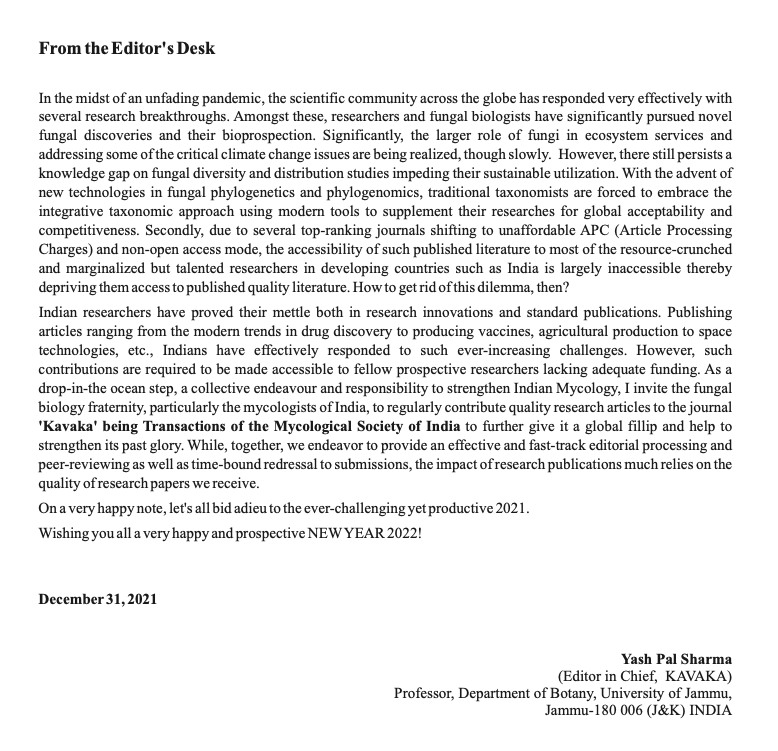

![]()

![]()

![]()

![]()

![]()

![]()
 KAVAKA 57: 33-37 (2021) doi: 10.36460/Kavaka/57/2021/33-37
KAVAKA 57: 33-37 (2021) doi: 10.36460/Kavaka/57/2021/33-37![]()

![]()

![]()

![]()

![]()

![]()

![]()

